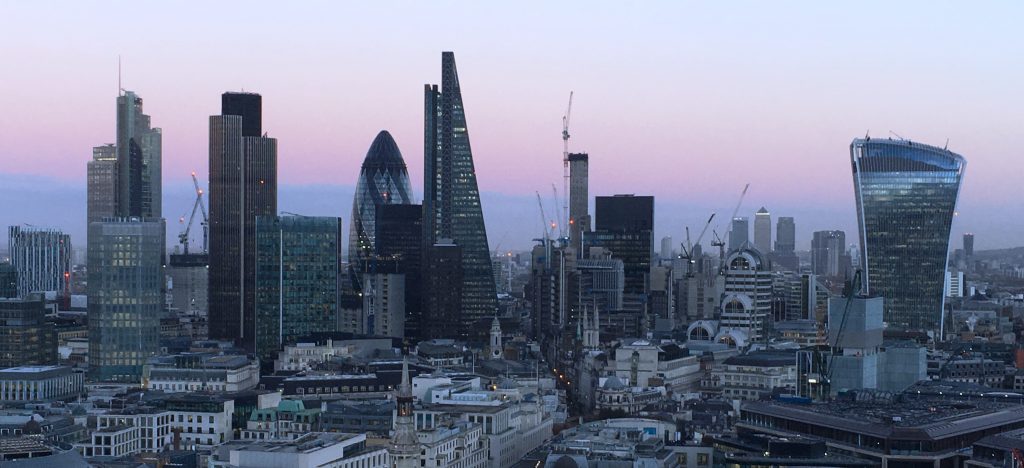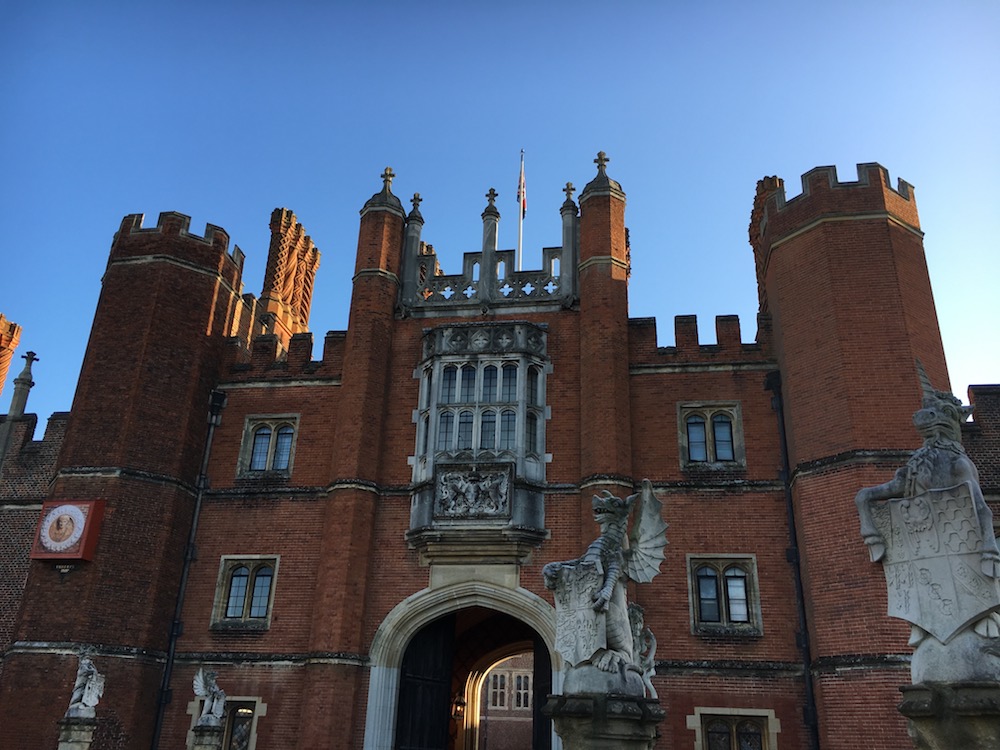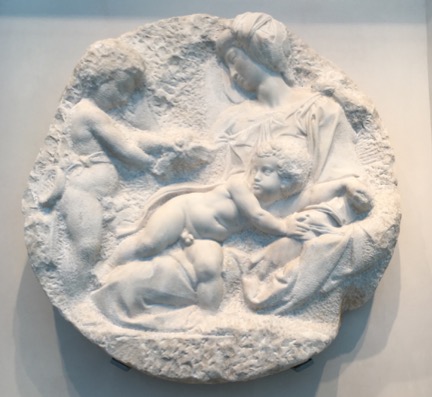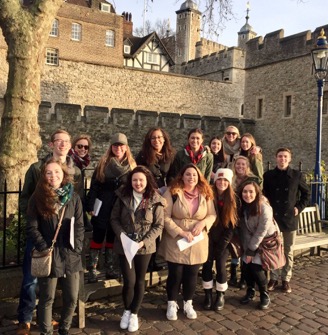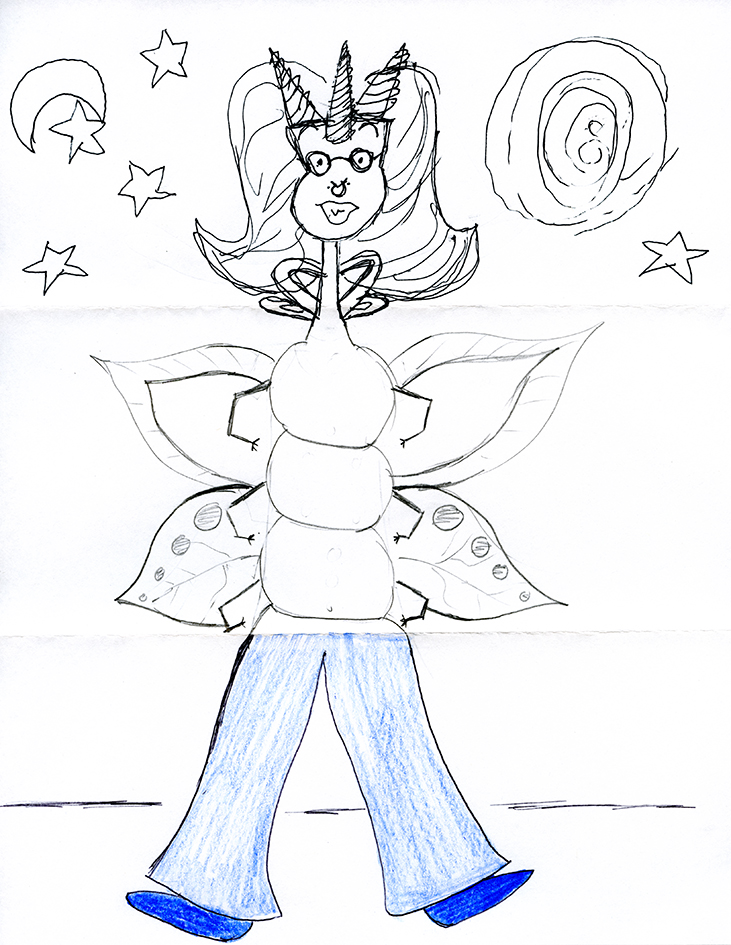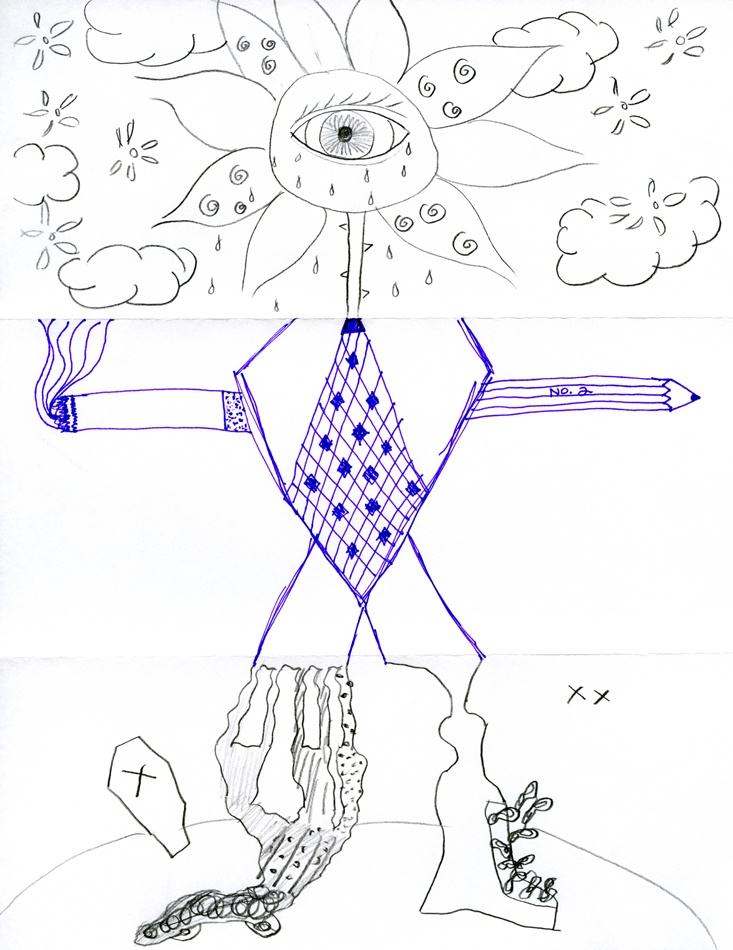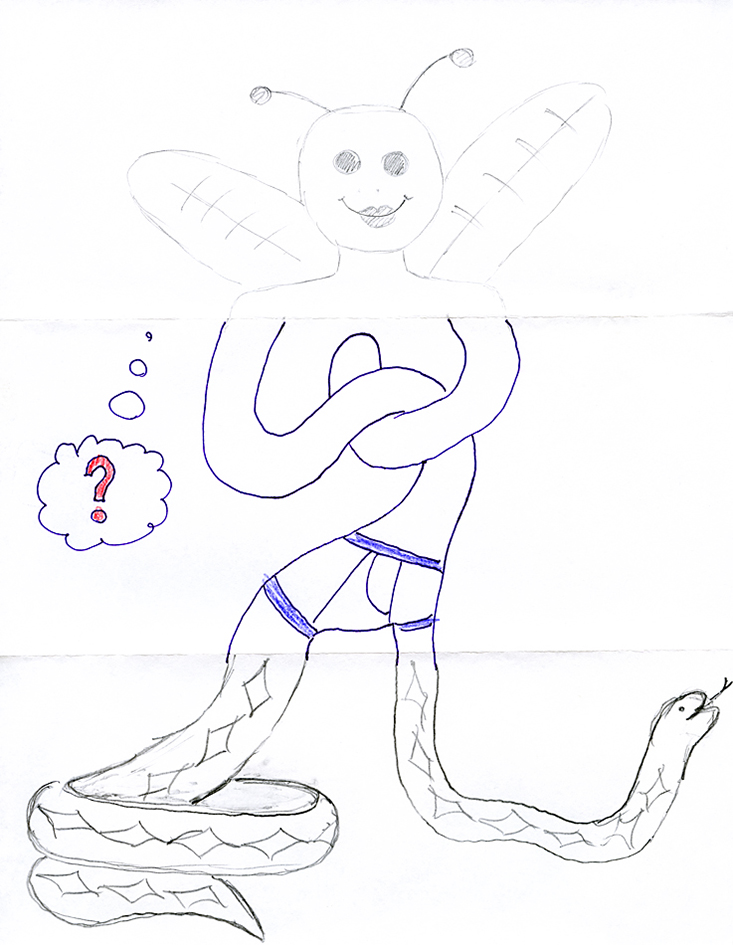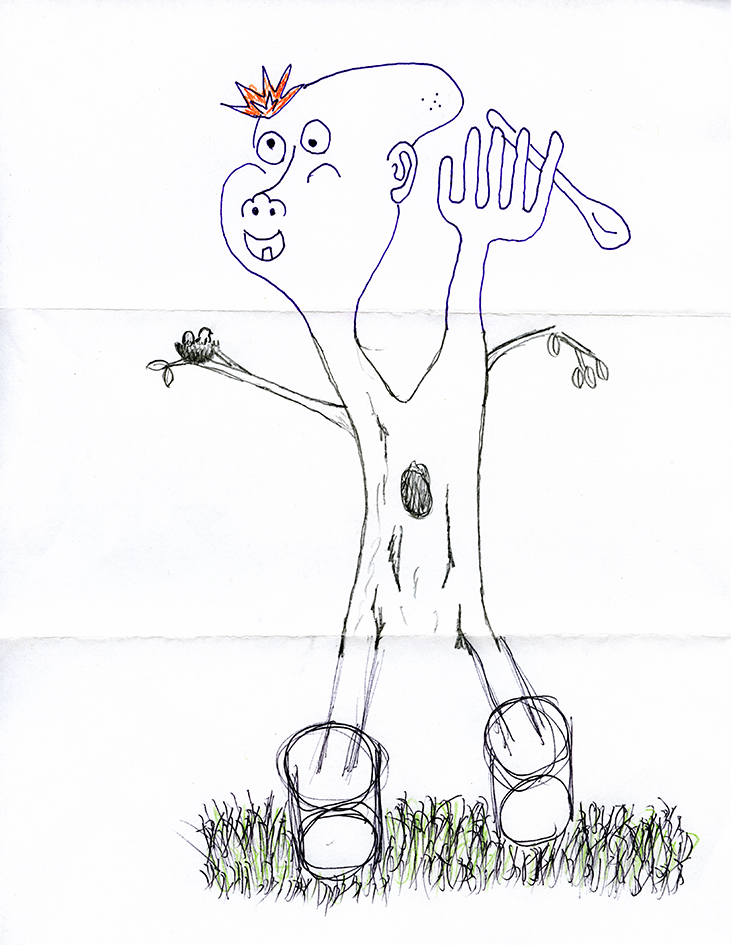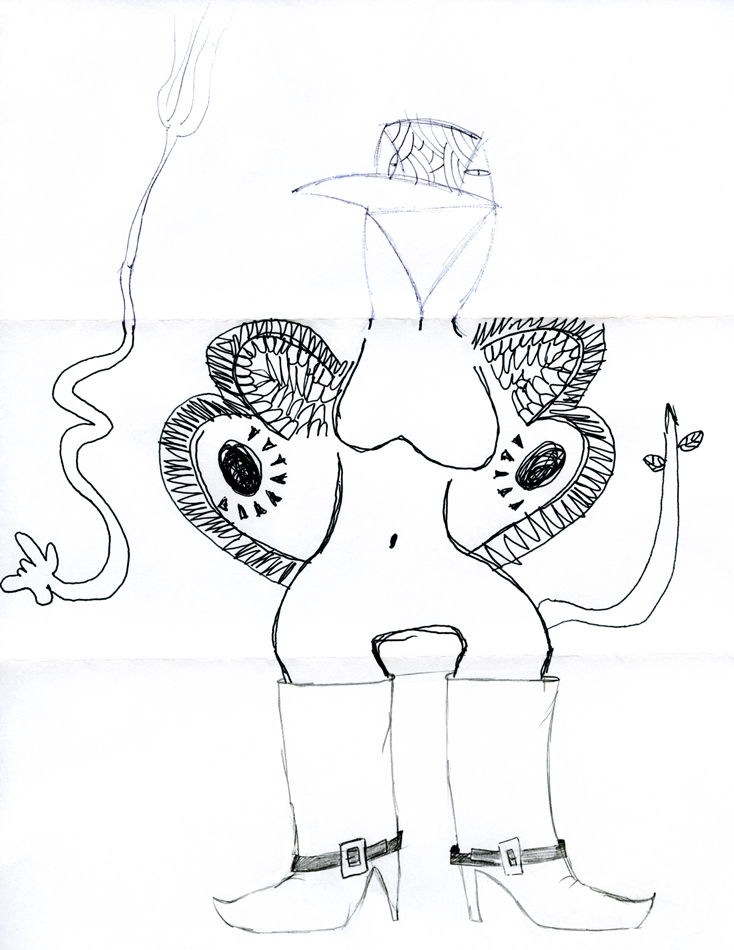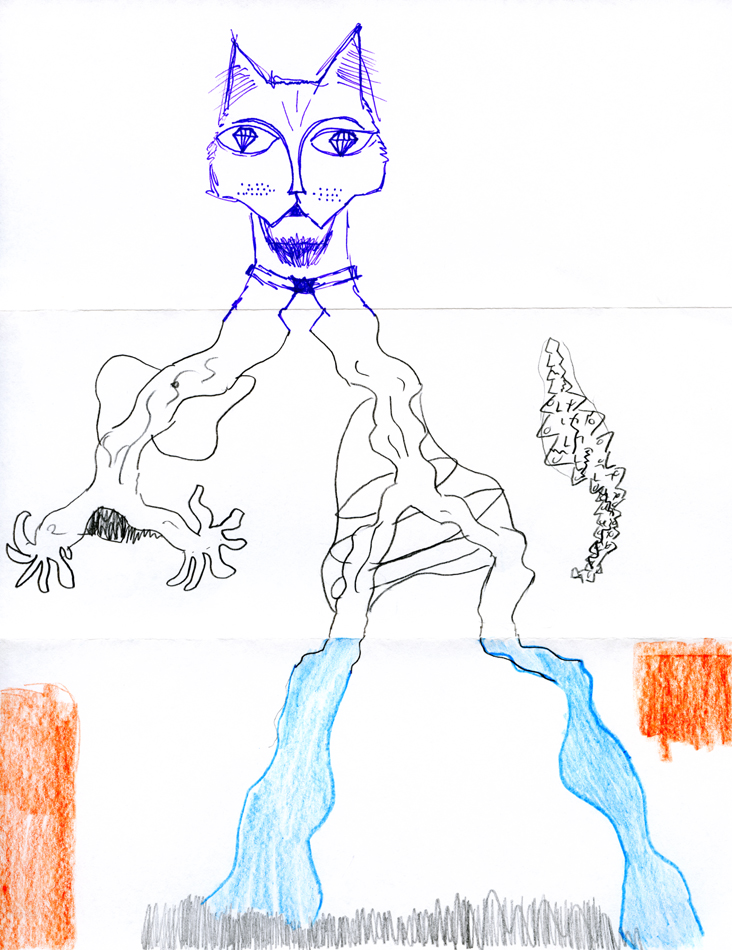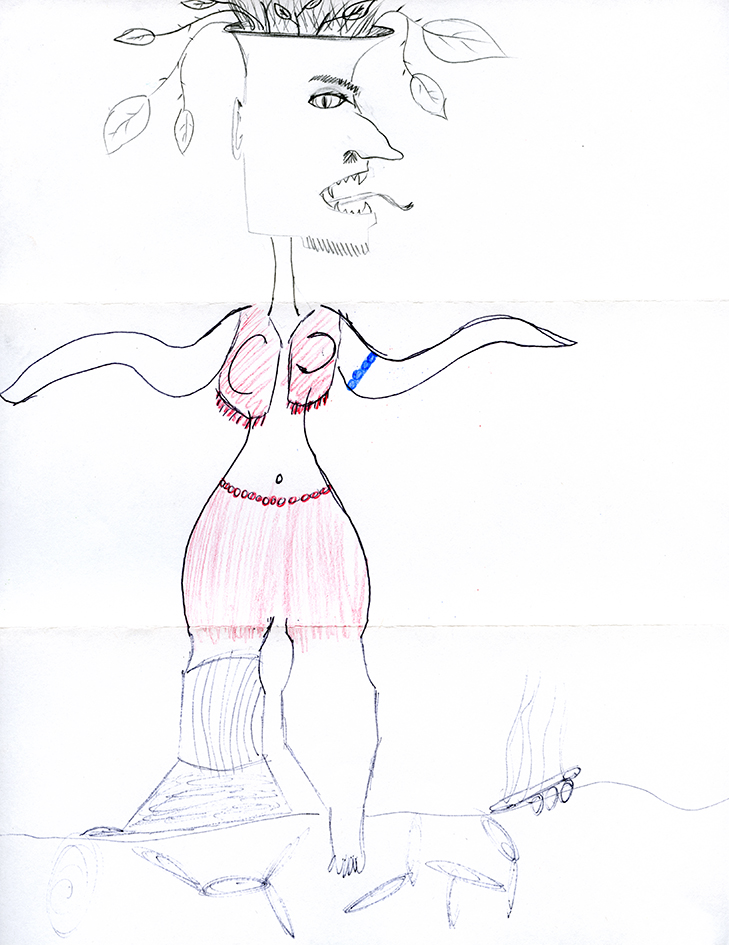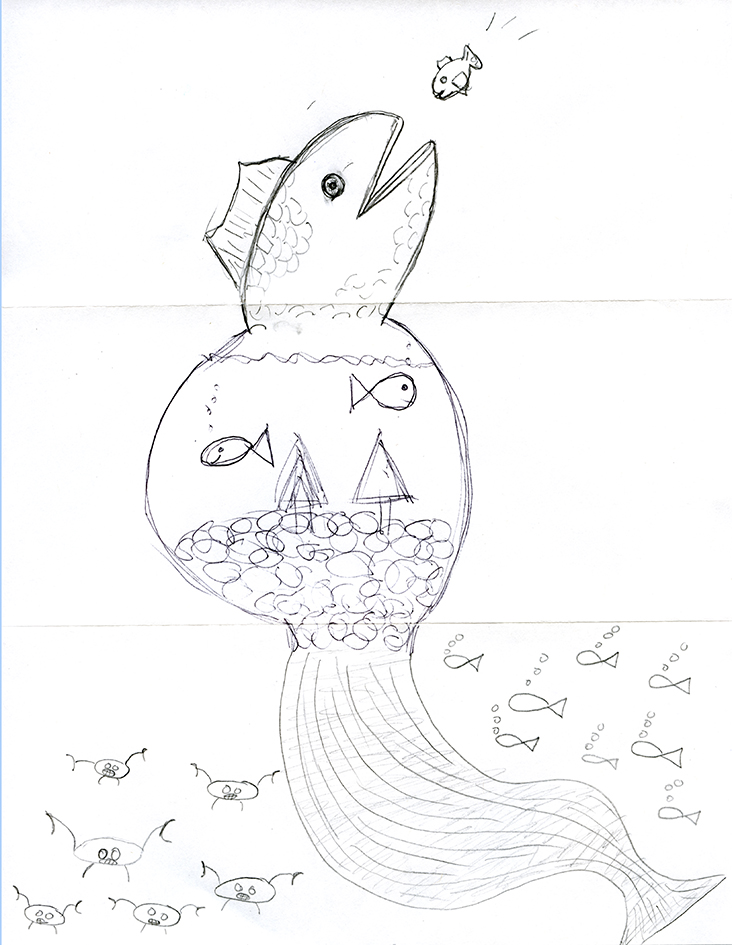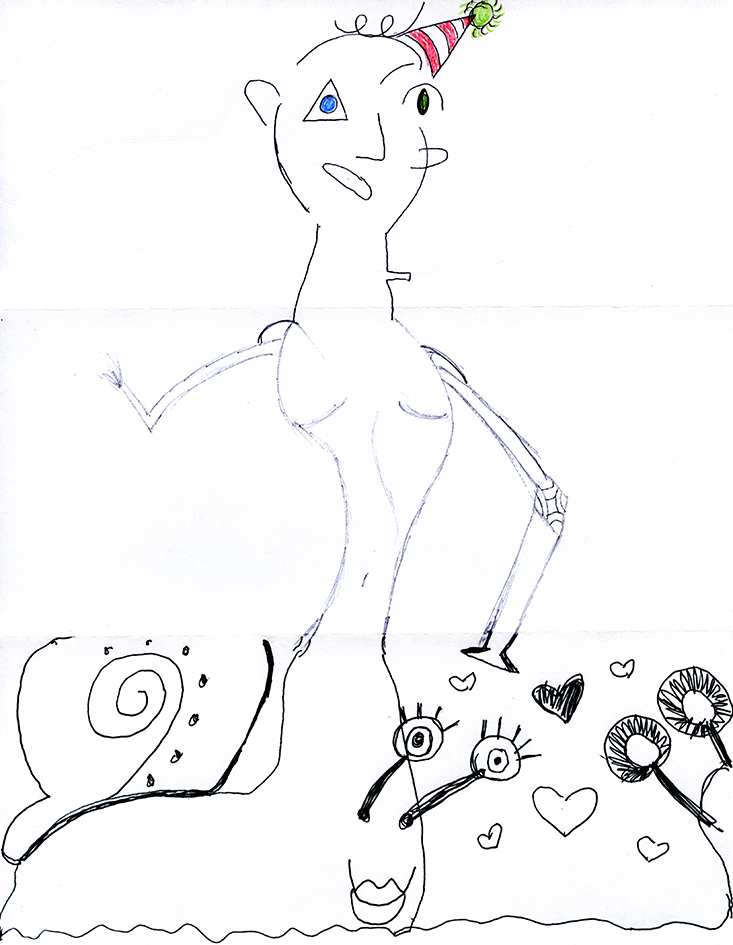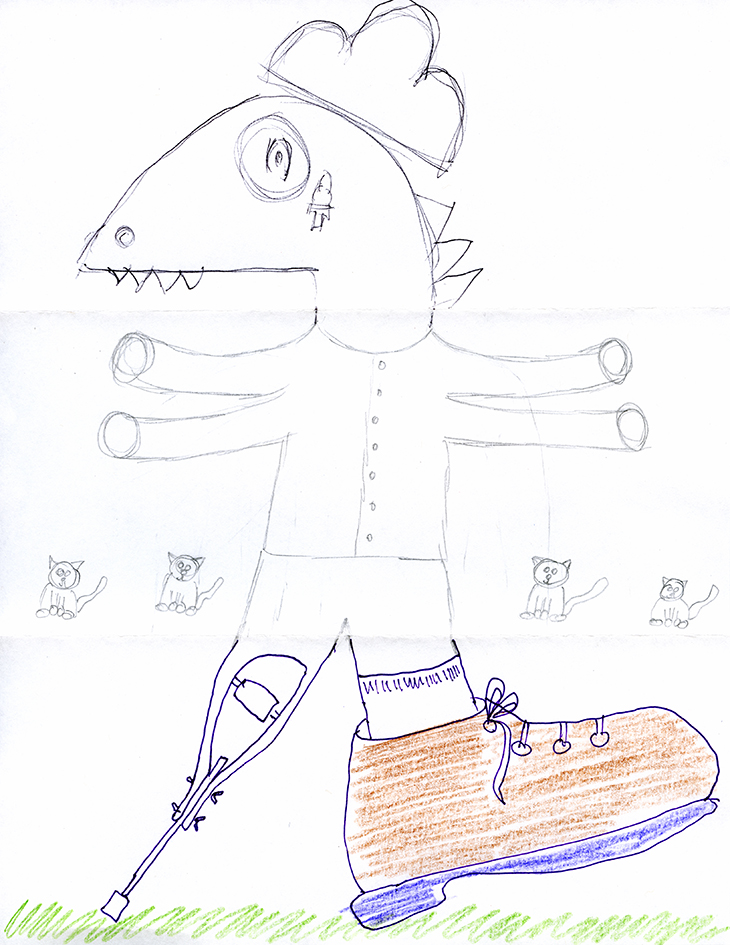Benjamin Schroeder is an undergraduate Art History major and recently went on a research trip to Florence, Italy. He is a Young Scholar this summer and received additional support from the Undergraduate Research Opportunities Program and an Art History Department Undergraduate Research Grant to help make travel for his architectural-focused project possible.
July 6th-7th: Viaggiare a Firenze
After researching all summer, the time to come to Florence has arrived! But getting here was no simple task. My plane left MSP at 4:25 pm, and I arrived in Paris CDG airport for my connecting flight to Florence at around 7:00 am. From Paris to Florence was a much easier flight, at less than two hours, I got here right about noon. Prior to this trip, I had spoken no Italian (as I took Japanese as my language requirement), So I had to equip myself with some Italian survival phrases, which got me to my hotel. My hotel just so happens to be in the same piazza as one of my buildings I am studying, the Santa Maria Novella. Being dropped off at the Santa Maria Novella Façade, done by Leone Battista Alberti (my favorite architect), was so surreal. Pictures that I have been studying have not done it justice. Seeing it in person is just such a different experience, the grand scale of it really sets in. The proportions seem so different, when you can actually walk around the building and see it from many different angles. I couldn’t check in until 2:00 pm, so I just took the longest time admiring Santa Maria Novella, and studying all of the details that can only be offered in real life. After I settled into my room, I set out to explore the city a bit and made it to the only building of this trip that is free to go in, the Palazzo Vecchio. The Palazzo Vecchio is the most famous secular building in town, a place where the royalty would speak to the people in the piazza below from a balcony. I didn’t use a map while getting there because I felt like I knew the city well after studying it all day everyday this summer. I knew the general direction I had to go, and I ended up getting there and back to my hotel very easily. Although, up until I actually got to my destination, I felt lost (even though I wasn’t), because the way the city is set up. Florence’s medieval city layout persists today, with buildings so close and roads so narrow, it can be hard to tell where you are. But anyway, I successfully got there and was able to see the grand gothic building and the replicas of Michelangelo’s David and Donatello’s Judith Beheading Holofernes. I felt just like a Renaissance Florentine standing in the piazza. I could just imagine looking up at the balcony and seeing the town rulers speaking to the people. After heading back to the hotel, I feel like I have a real grasp for the city, and I that I am amply prepared to set out again tomorrow! Somehow, I have been up for more than 30 hours, so I can go to bed at a normal time, no jet lag! I am excited for going to the Uffizi Gallery and San Miniato al Monte tomorrow!
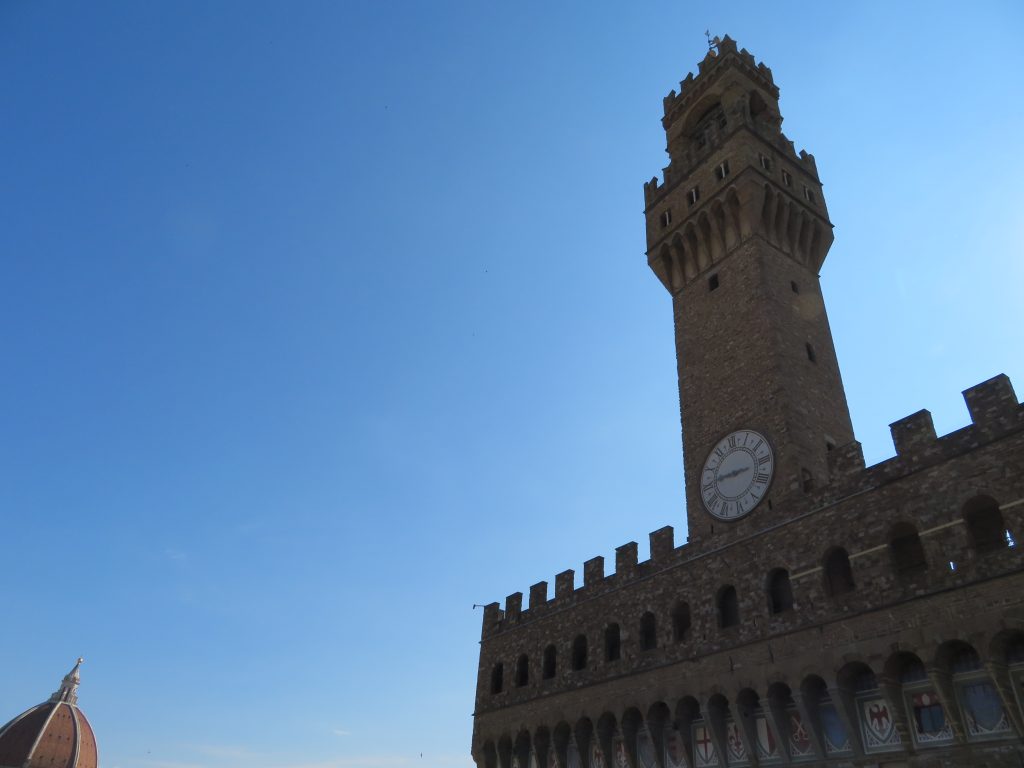
Palazzo Vecchio, exterior.
July 8th: Uffizi e San Miniato al Monte
I started the day around 4:00 am today, took my time getting ready and then went up to the rooftop terrace at my hotel, which has a spectacular view of the Santa Maria Novella, and I relaxed and took some nice photos. The terrace has a great panoramic view of the city too, offering a good view of the Duomo and its campanile (bell tower), as well as San Lorenzo. Breakfast at my hotel starts at 7:00 am, so after brushing up on some Italian phrases and know-hows, I headed to eat. My Uffizi reservation was at 8:30 am, so after breakfast I left to my destination. I figured out the trick to getting to most places in Florence is to just go along the Arno river and then dive into town when appropriate. The Arno is practically the only place where you can go in a straight line, everywhere else has seemingly arbitrary turns everywhere and you can get disoriented very easily. I am studying architecture, so why go to an art gallery? The occupation as we know today as a professional architect did not exist in the 15th century (not until the 18th century did being an architect become a professional craft). The people who ended up making these beautiful buildings that we are familiar with today were artists and sculptors. Take the architect of the cupola (dome) at the Duomo, Brunelleschi, for example; he was a goldsmith by trade, yet being the Renaissance man he was, he had the math/engineering knowledge to be an architect. So, when yesterday I mentioned that Alberti is my favorite architect, he was actually much more than that (Alberti was actually the first Renaissance man, being an expert in a great number of things). The halls between the galleries are filled to the brim with large sculptures around the perimeter. It’s crazy to see how on some of the labels it will say that the piece was acquired by the museum many hundreds of years ago; it really makes you realize how old the establishment is. My favorite paintings were The Birth of Venus by Botticelli and Raphael’s The Virgin and Child with Saint John the Baptist. After the Uffizi, I made my only trek south of the Arno, going to the high point of the city at the Romanesque church San Miniato al Monte. I wasn’t sure if I could go inside the church, but sure enough, the door was wide open. I was walking through the big church where there were no lights and just windows, it seemed derelict. But then I heard an organ playing, and realized a church service was just ending, I had forgot it was Sunday! After it ended, I explored the area where the service was held. Before I knew it, another service was starting, so I figured I would take advantage of my opportunity to attend a church service in Italy in a centuries old building! I don’t speak Italian, but somehow I made some Italian friends during the service. By now it was late afternoon, and I headed back to the hotel, ate and it was time for bed again already! Tomorrow I have Bargello in the morning and Santa Maria Novella in the afternoon!
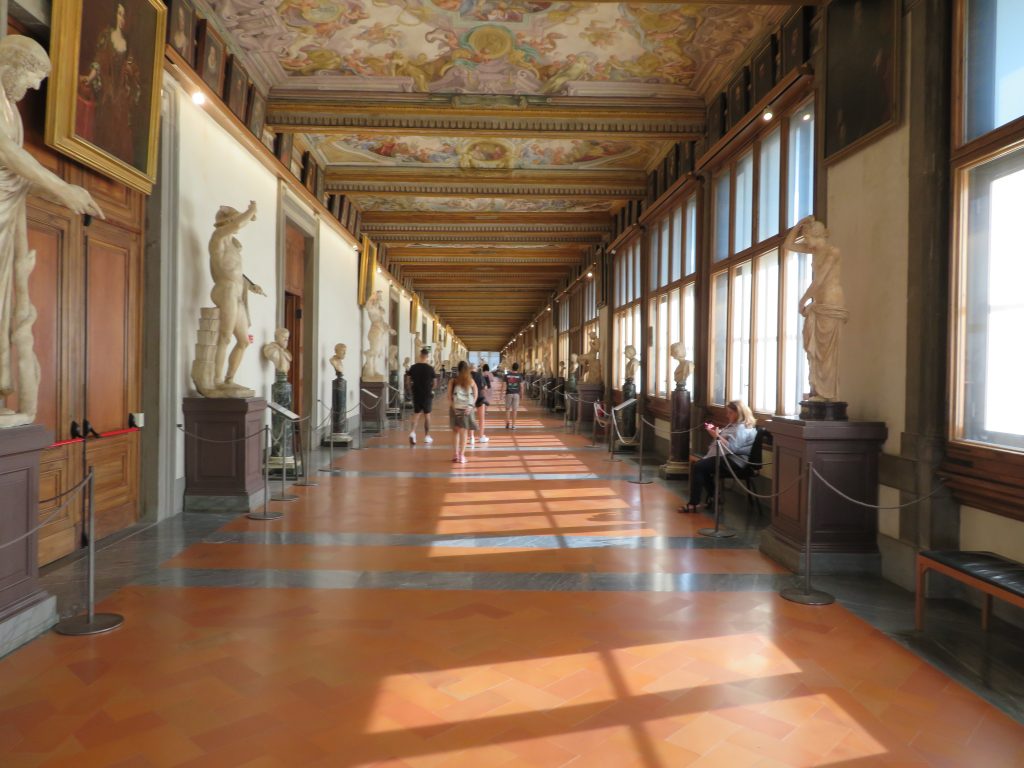
Uffizi, interior.
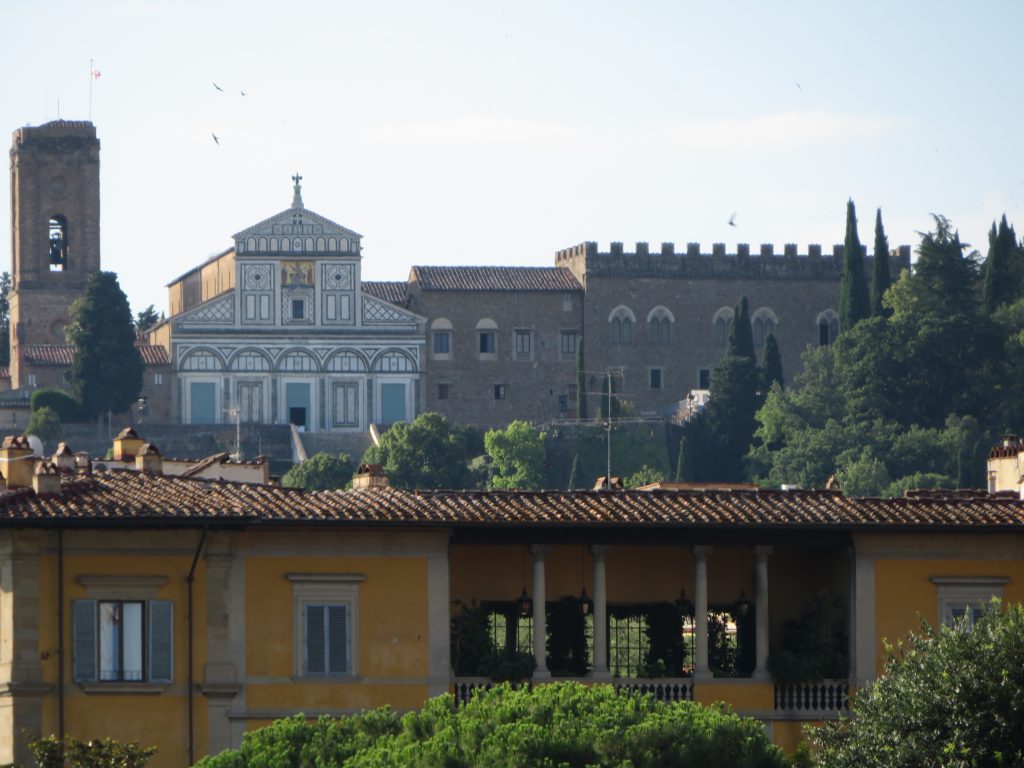
San Miniato al Monte, exterior.
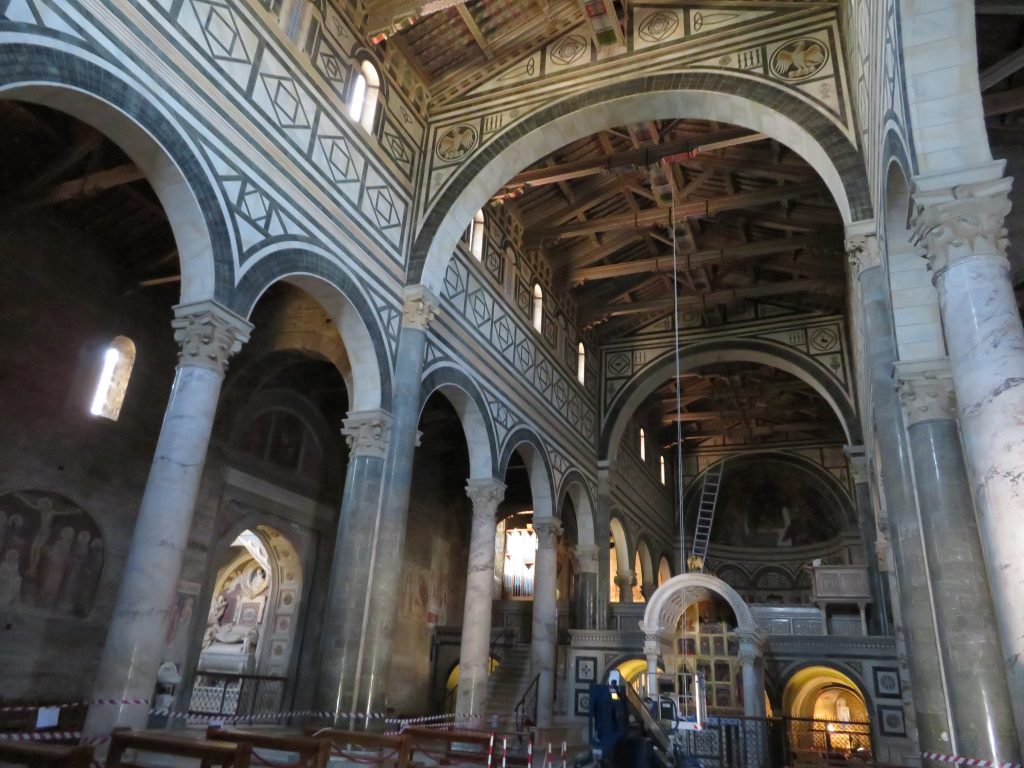
San Miniato al Monte, interior.
July 9th: Bargello e Santa Maria Novella
4:30 am is the best time to get up when abroad, I am convinced. After breakfast, I headed out to my 8:30 am reservation at the Bargello Museum. The Bargello is known for having some of the most famous sculptures in the world, namely ones by Donatello. Unlike the Uffizi, which was very crowded at opening, the Bargello was almost empty, save for this Londoner and his family. My goal was to find Donatello’s 1440 bronze David, yet when I walked into a room and saw it I was completely taken aback. Seeing all of these great works that I have been studying for so long is like a dream. The greatest part was that I was completely alone in the room, and could go right up to the sculpture. No railing or any other obstruction, just me and the 578-year-old masterpiece. I had access to unlimited angles, giving an unparalleled experience (I see Michelangelo’s David tomorrow at the Academia and I doubt I will have this freedom of viewership). Not too far away from this bronze nude (the first nude of David since antiquity), was Donatello’s first David, which is a stark contrast with his more well-known one. This David is clothed and resembles a classical style. Hidden in the corner of the room, are two gold panels. These panels are from the 1401 competition for the commission of the panels on the east door of the Baptistery of San Giovanni, the competition was to create a panel of the Sacrifice of Isaac. One was by Filippo Brunelleschi (who just so happens to be the architect of the dome at the Duomo) and the other was Lorenzo Ghiberti. This legendary competition yielded two masterpieces depicting the same thing. The story goes that the competition either ended in a tie, and that Brunelleschi withdrew because he didn’t like ties (or something), or that Ghiberti out right won. I was not expecting to see these, as David was my focus, and I was absolutely blown away and had to stare at them for a great length of time. I am not ashamed to say that I spent hours in that room, in sheer awe of what I was in the presence of. As it got closer to noon, I supposed it was time to leave. Santa Maria Novella was my next building, and I am living right next to it this week, making it the easiest place to go yet. But before I went there I had lunch and figured out where Santa Croce is (my building for Wednesday). In case I haven’t mentioned this, Santa Maria Novella’s façade is hands down architecture at its finest. I’ve already been analyzing it from the outside my entire trip, but today I got to go inside—which did not disappoint. My first objective was to find Masaccio’s Trinity, as it is one of the first (maybe the first?) to implement Brunelleschi’s one point perspective technique in painting. When I found it, I realized I totally forgot it was a fresco, it was painted straight onto the wall! This makes its architectural elements even better, tricking the observer to thinking that he/she is viewing architecture. Sta. Maria Novella has such grand Gothic pillars and arches inside, making for a massively open environment. I felt very close to God here. After sitting in the pews and enjoying the presence of God, I wandered about and realized you could explore the cloisters. The same style of the nave was translated to the cloisters, just on a smaller scale, which was great because it gave a closer look at the vaulted arches of the ceiling. One thing you’ll notice in my pictures is that the medieval tower of the church is being refurbished, and that it is comically covered with a picture of the tower itself. Nonetheless, I walked away from Sta. Maria Novella a very happy young man. I will of course continue analyzing its façade for the rest of my stay. Up tomorrow is what many visitors here would consider the two main events: 1) The Santa Maria del Fiore (Il Duomo) and the Academia art gallery (which houses Michelangelo’s David). Can’t wait!
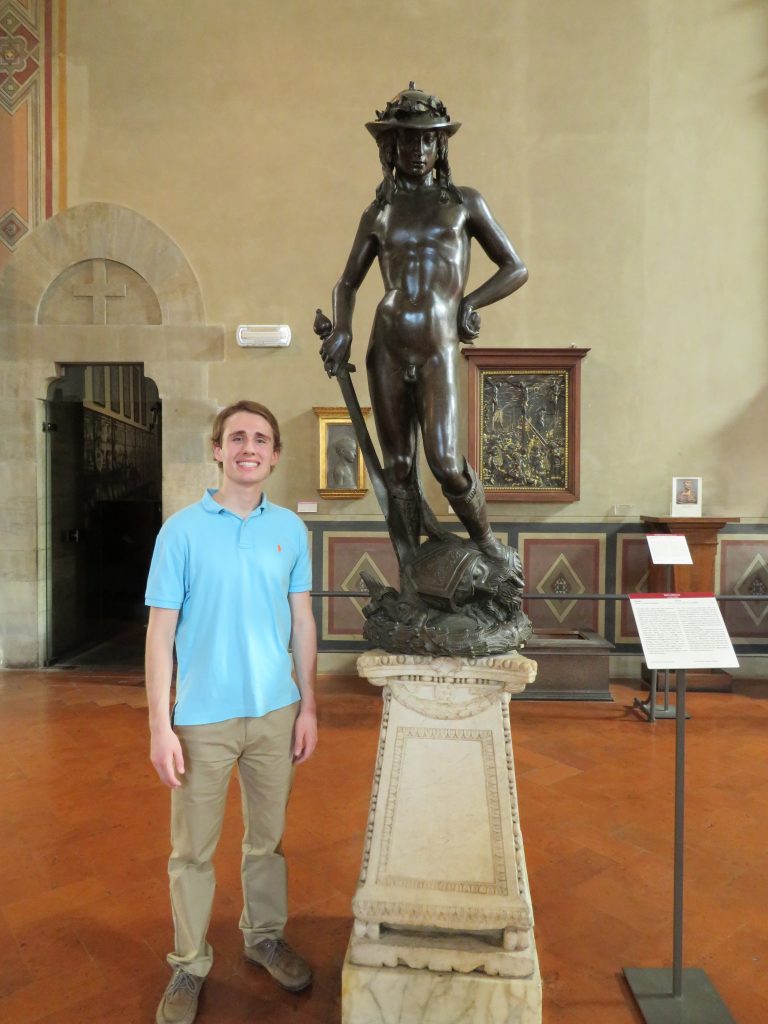
Me with Donatello’s David inside the Bargello.
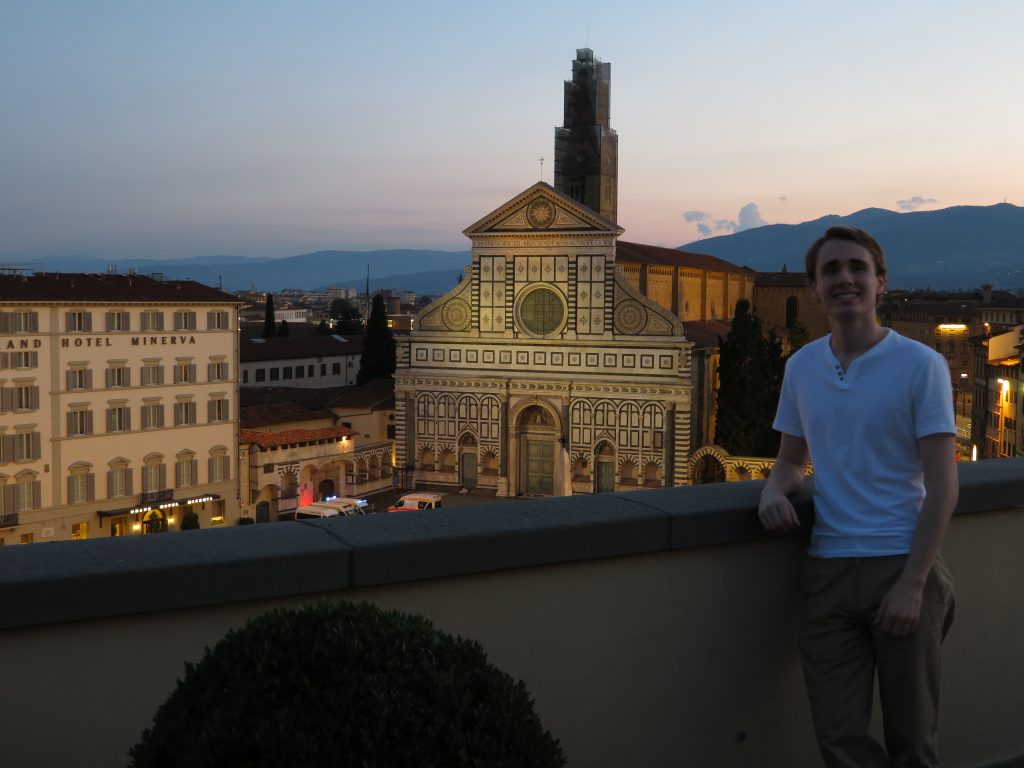
Me at the rooftop of my hotel overlooking the Santa Maria Novella.
July 10th: Santa Maria del Fiore—Il Duomo, e Academia
I begin my day again at 4:30 am, mornings here are wonderful. The rooftop terrace offers a great place to watch the sunrise. After seeing it everywhere I have gone this trip, it was finally time to visit the Duomo. There was an endless line, but luckily, I had reserved a tour and got to skip the queue (people gave me some nasty looks of jealousy). My tour took us inside the cathedral, and we got to go to some off-limit areas. After that, we made the ascent up the cathedral and got to go out onto the terrace just under the dome. The lady that gave the tour was awesome, she taught me so much. The tour ended on the terrace, but we had the option to go all the way up the dome onto the lantern to get the best view of the city, which of course I did. It was a great experience, I could see everywhere I had visited on the trip thus far. After spending some time up there I went back to the bottom. My ticket allowed me to go into the Baptistery of San Giovanni and the campanile (bell tower), but at this point the lines were long and I still had to get lunch before going to Academia. Fortunately, the ticket lasts for 72 hours, so on Thursday, my last day, where I do not have any reservations for anywhere, I will head up there early. Next up was the Academia Gallery, which is home to Michelangelo’s David. There’s some other really cool stuff there too, such as Michelangelo’s Pieta (not the famous one), and a lot of other sculptures, but David is definitely the center of attention. That rang true for me too, I spent I do not know how long looking at David and getting pictures of as many angles as I could along with close ups of the details. After I was done with David, I left and explored the rest of the museum, and when I finished with that I planned on getting one last glance of David and then leave. But, some time had gone by, which meant the time of day had changed, which meant the earth had rotated in a manner that changes Florence’s reception of the sun, which meant there was new lighting on David! So, I had to get all the same angles as I took before, but with this new, warmer light. Everyone is so used to seeing David front on, where he is looking to the side, but never at an angle to get a real good look at his face. Getting a photo of David’s face straight on looks so different. I’ll include a photo so you can see. After all of this, nighttime has come again, my trip is going by so fast! Tomorrow is my last reservation for somewhere, and it is the church of Santa Croce! I had already walked by it when I visited the Bargello, so I know exactly where to go!
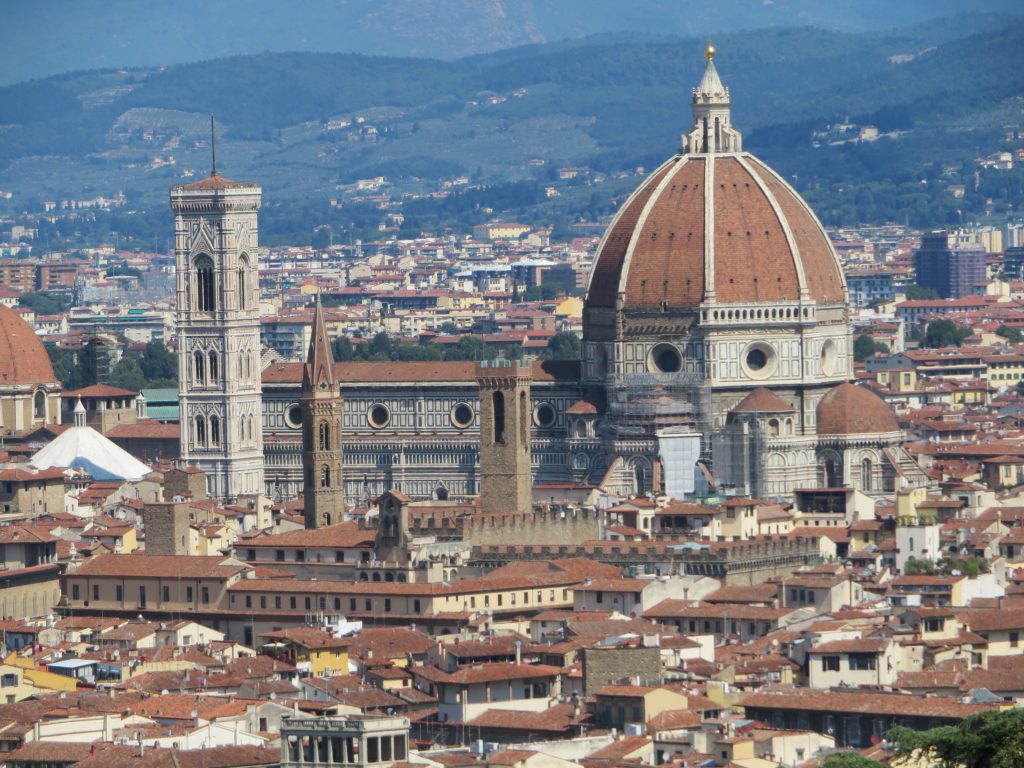
Santa Maria del Fiore (Duomo), exterior.
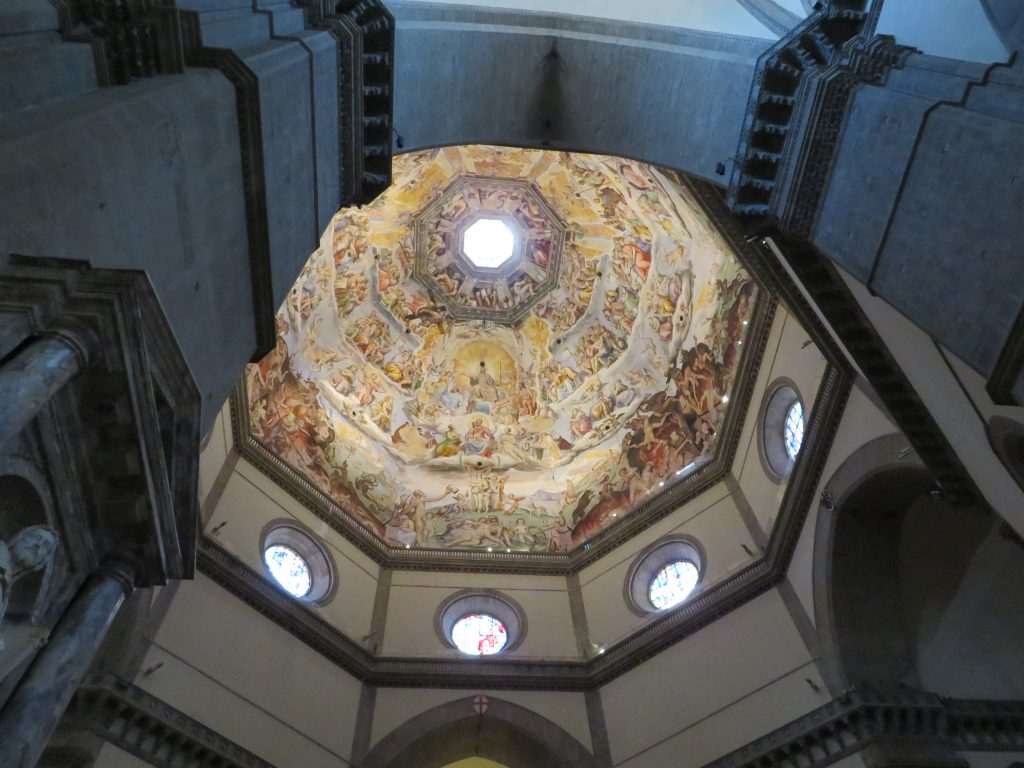
Duomo, dome, interior.
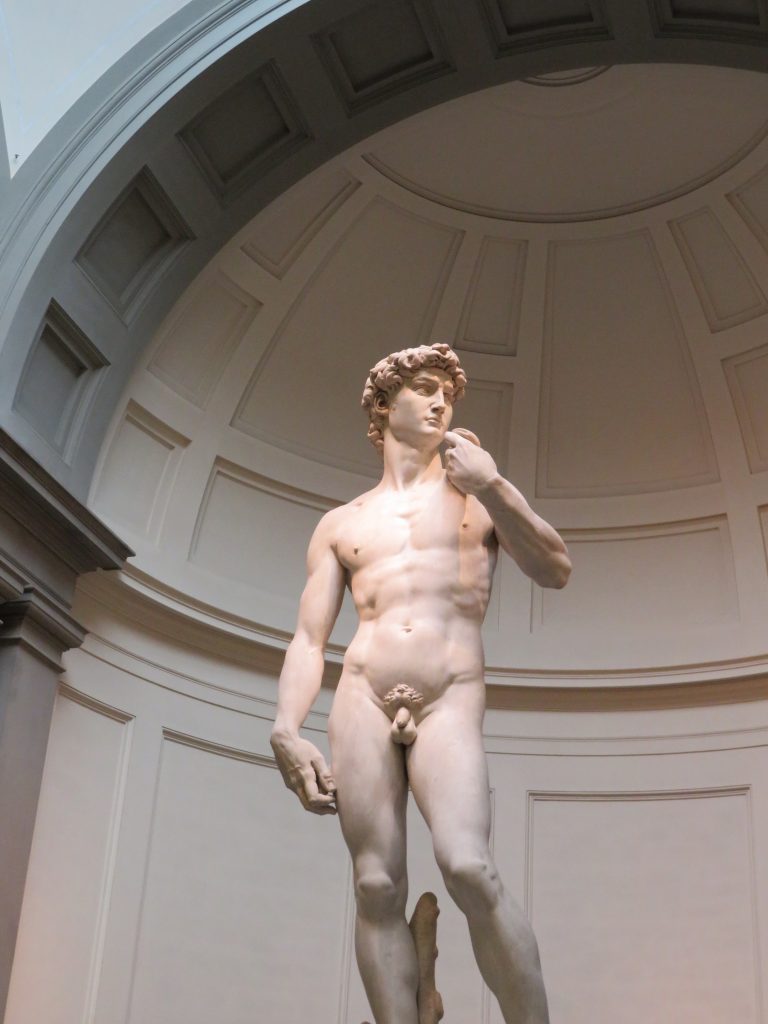
Michelangelo’s David at the Academia.
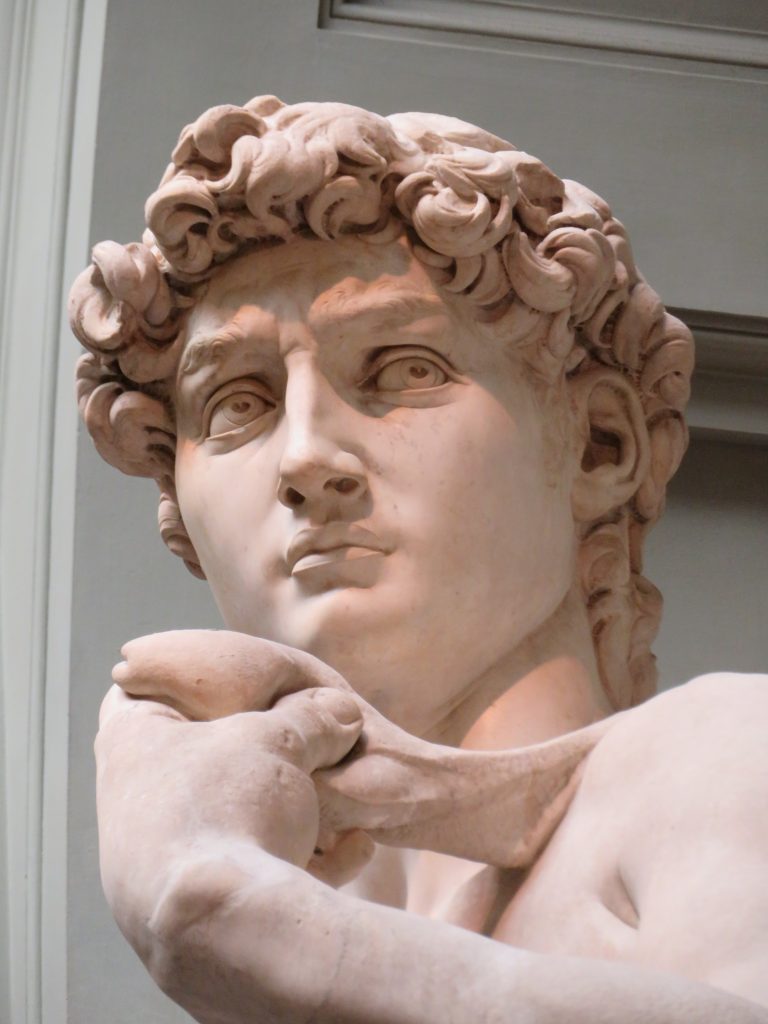
Close up of David.
July 11th: Santa Croce e San Lorenzo
I got up late today—5:28 am. I didn’t have time to lounge much before going to 7:00 am breakfast. Santa Croce is interesting, because like Santa Maria Novella, it is a medieval Gothic church with an eye-popping façade. The difference here is that this façade is neo-Gothic, where Sta. Maria Novella’s is Renaissance. But Santa Croce has one very important Renaissance factor—the Pazzi chapel! The Pazzi chapel is considered by some to be the greatest example of Renaissance architecture. Researching the Pazzi chapel has been slightly annoying though, because everyone has always thought it was made by Filippo Brunelleschi, the same guy that did the cupola on the Duomo. So, most scholarship that I have been reading reflects this. But one of my favorite architectural historians (second only to my advisor), Marvin Trachtenberg, has recently made the case (and it’s a compelling one) that the Pazzi chapel is not by Brunelleschi. He notes how different the Old Sacristy in San Lorenzo (which is more or less confirmed to be by Brunelleschi) is with the Pazzi chapel. This is why I am going to San Lorenzo today, so I can do some comparisons myself. I just got back to my hotel from Santa Croce this morning, and have not visited San Lorenzo yet. The battery in my camera has died, so I am hanging out while that charges. I haven’t decided yet if Brunelleschi made Pazzi chapel or not, hopefully I will have a better idea when I go to San Lorenzo. I have no reservations at San Lorenzo because they wanted my passport number online for some reason, so hopefully I can wander in there today. Anyway, I got off track a bit, back to Santa Croce. Like the other churches I have gone to, it has massive gothic pillars and arches inside. What makes this interior stand out is the people who are buried there. The main people were Dante Alighieri (The Divine Comedy), Michelangelo Buonarroti (David), and Galileo Galilei (Heliocentric model of our solar system), and Leone Battista Alberti (Santa Maria Novella façade!). They all had marvelous tombs and sculptures above their burial sites. It was weird to think that these famous figures’ bodies were so close to me. After hanging out with the dead guys, I went over to Pazzi chapel to examine it for myself. It definitely is spectacular, I’ll have to go to San Lorenzo’s Old Sacristy to see if I have an opinion on if it is by Brunelleschi.
Just got back from San Lorenzo, and I understand why these two places are compared. They are basically exactly the same! Both have rectangular plans with a dome in the center with an adjacent apse. I read an article that enumerated how these two places are different, so I will have to go back to that and see what exactly it says, as they seem so similar. So, at the moment I cannot give an opinion on if it is by Brunelleschi or not. On one hand you could argue that since they are so similar it had to have the same mind behind both of them. But on the other hand the plan could simply have been copied and have nothing to do with Brunelleschi. Either way though, Brunelleschi is involved, be it directly or indirectly. Now I am officially done with all of my reserved visits and tours, feels kind of sad I am nearing the end of my trip. But I still have one more day and I think I’ll spend the morning near the Duomo looking at the Baptistery and the campanile. Not sure what I’ll do for the afternoon yet. I intentionally left one afternoon open in case I came across anything that I felt like I needed to visit when I got here, and I have some ideas but I won’t mention any yet until I have formulated a plan. Off to dinner, see you tomorrow!
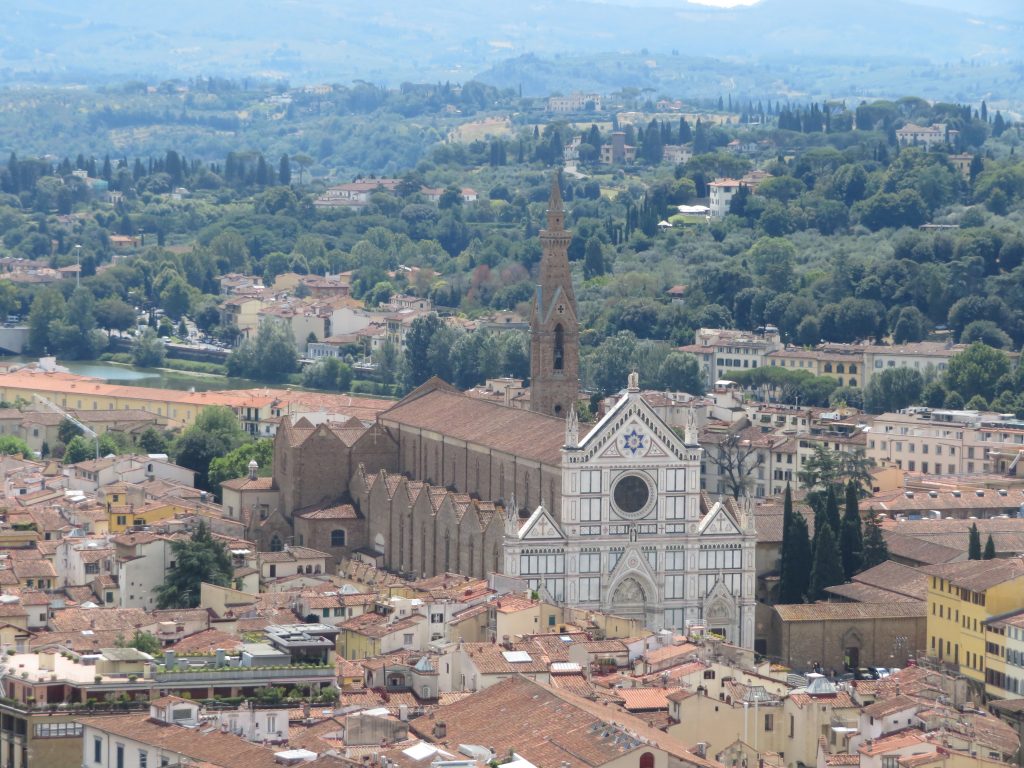
Santa Croce, exterior.
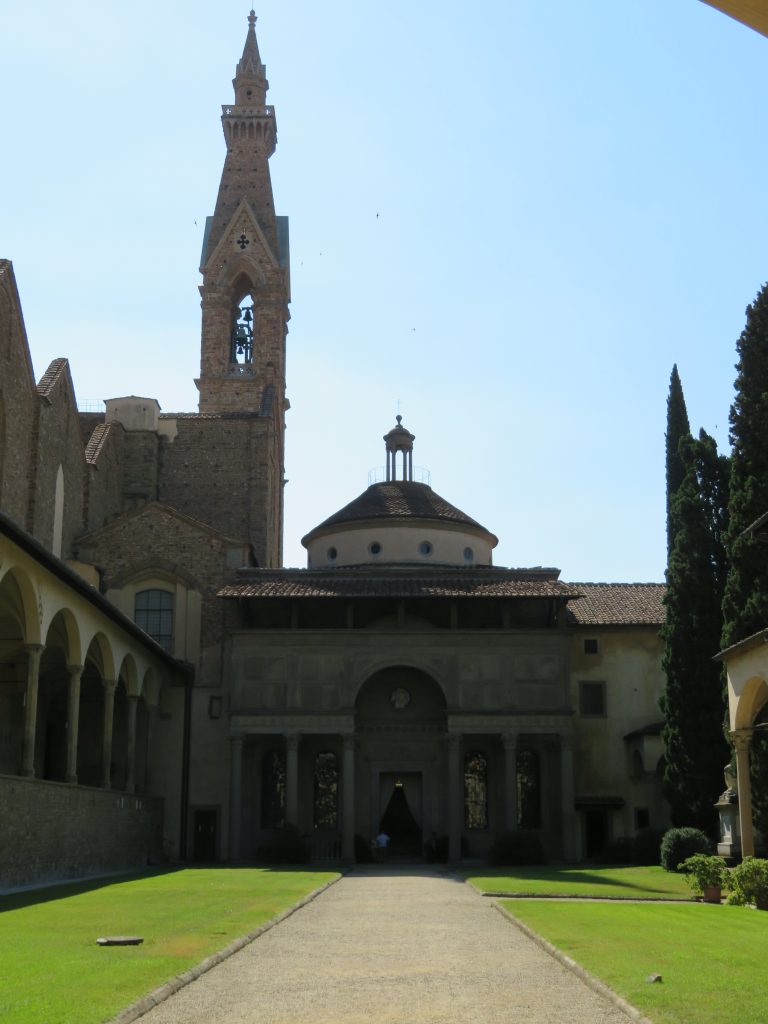
Pazzi Chapel (at Santa Croce), exterior.
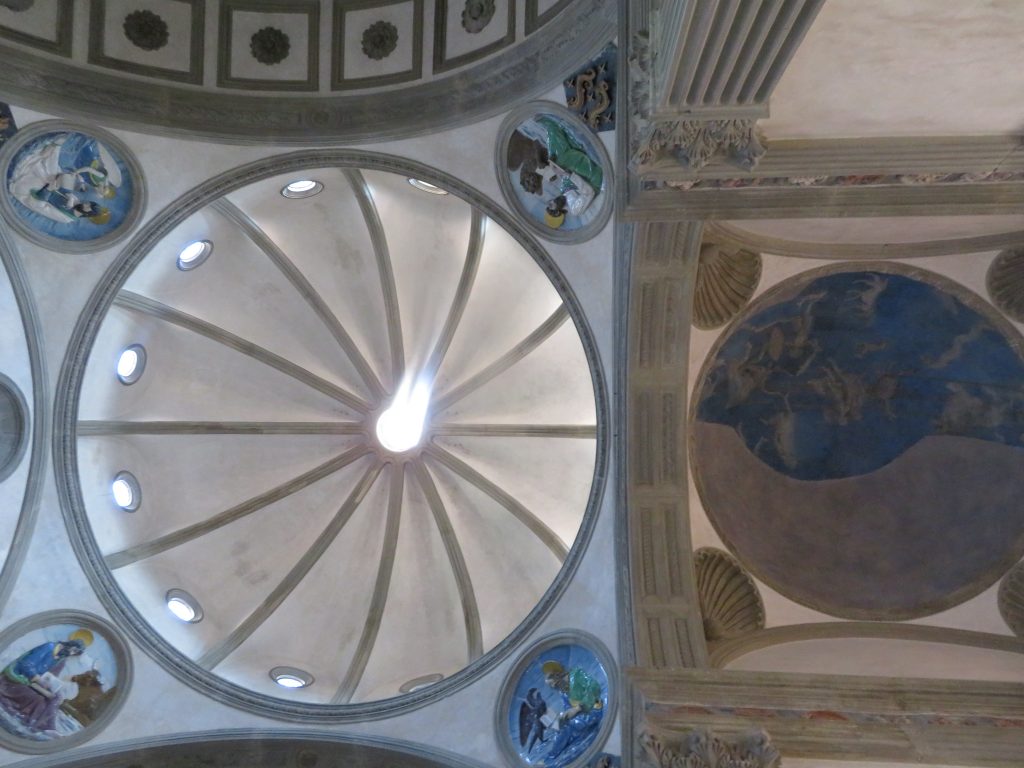
Pazzi Chapel, ceiling.
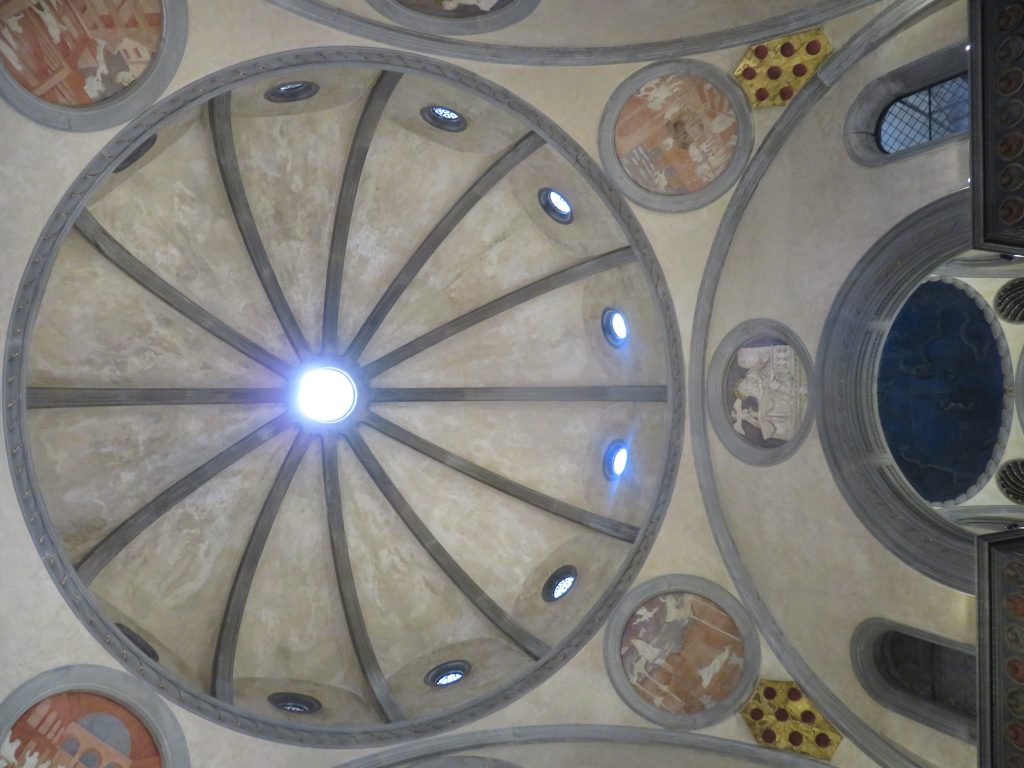
San Lorenzo, Old Sacristy, ceiling.
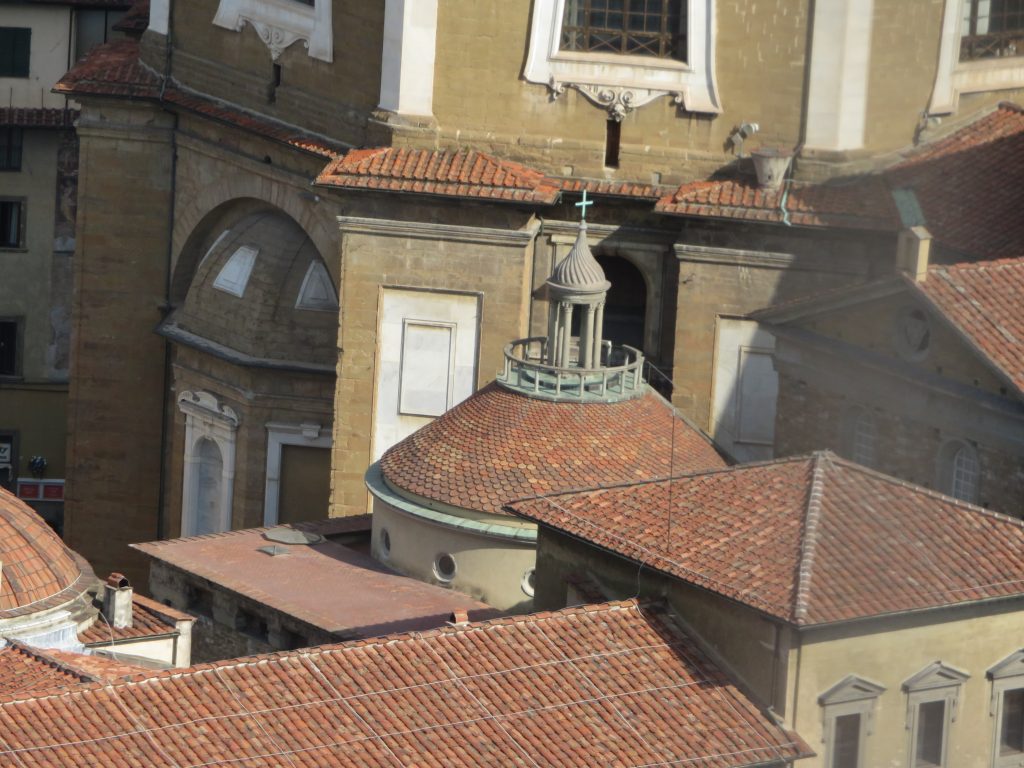
Old Sacristy at San Lorenzo, exterior.
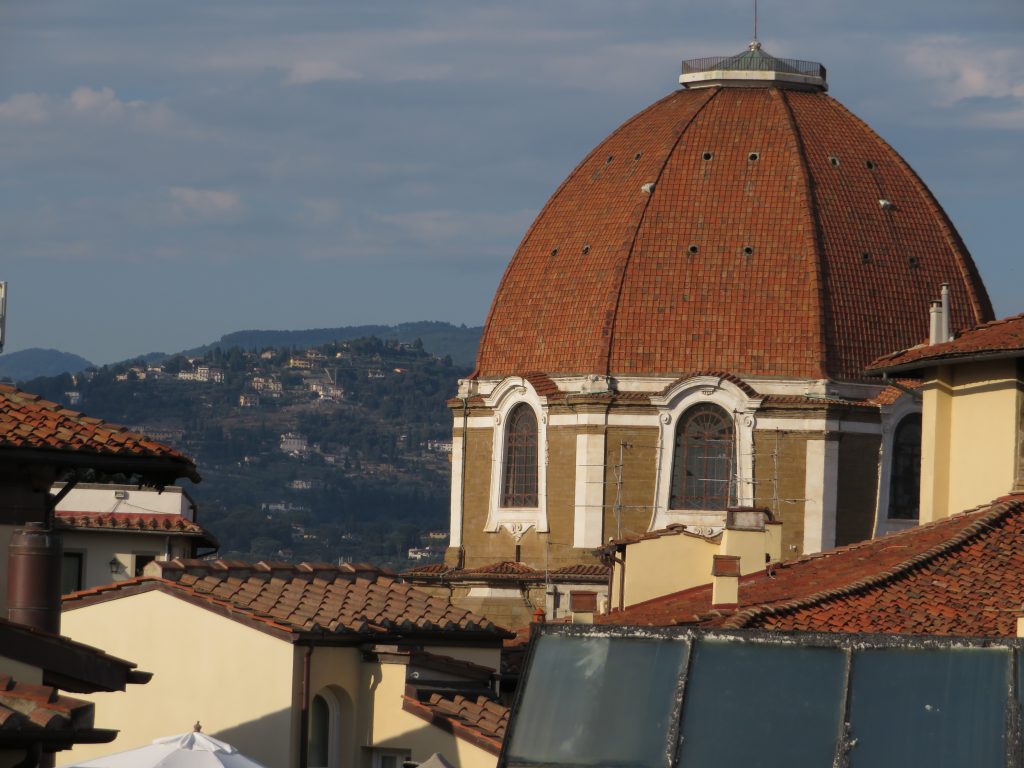
San Lorenzo, exterior.
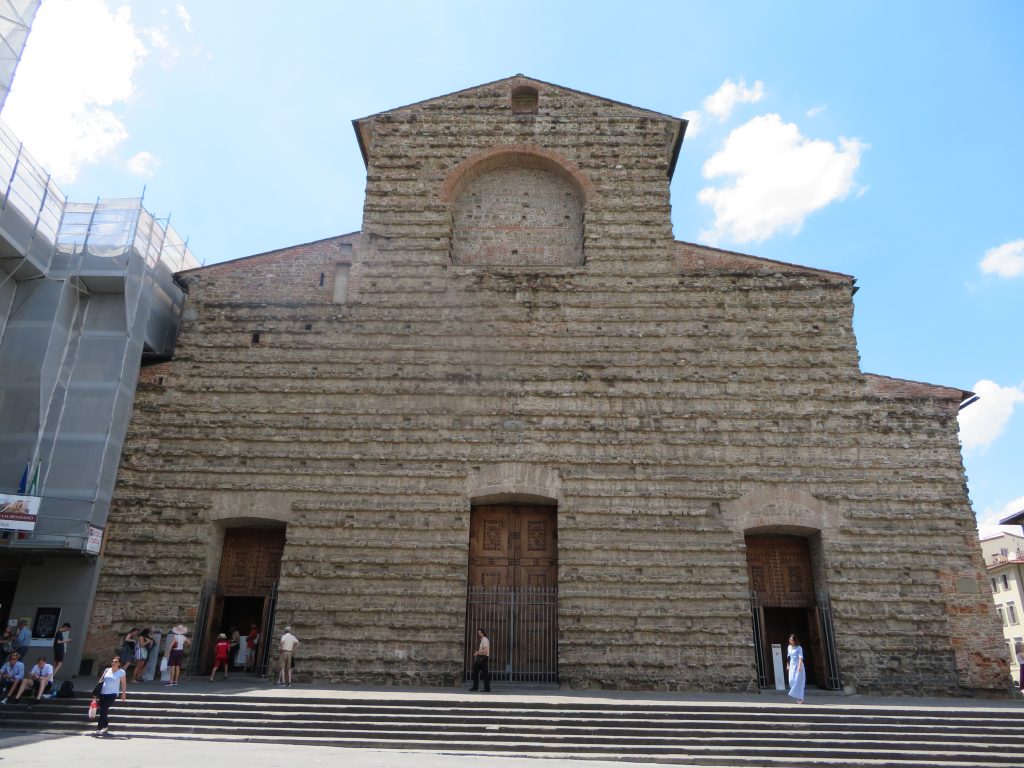
San Lorenzo, façade.
July 12th: Campanile e Baptistery di San Giovanni Battista, e Palazzo Rucellai
My last full day here, I am sad but also overjoyed that the trip has gone so well. I am heading back to Duomo’s piazza to head up the campanile to get a great view of the Duomo and the city, and also to the baptistery. In Florence you eat a lot of carbs, but you also walk a ton, so it balances out. This especially applies when going up the campanile, where there were as many steps as there are people in all of Florence. The campanile gives a perfect view of the Duomo for some great pictures. The only problem was that there was a cage around the top of the tower so it made a bad place to take pictures. Luckily there were some windows on the way up so I got some good pictures from there. It was so weird to think I was heading up in these areas that hundreds of years ago were off limits to most people. The top of the tower gives the best panoramic view of the city, and what I loved most about it was that I was there at the end of my trip, so I could point out every single place I had been! By now, I know Florence like the back of my hand, so seeing it from this view was pleasing. After staying up there for far too long, I headed down to the baptistery. The Baptistery of San Giovanni Battista lies adjacent to the Duomo, and is one of the oldest structures in the city. It is a Romanesque church (long thought to actually be a Roman church, although it is not) made between 3rd-5th c. CE with the present marble revetment done between 11th-13th c. CE. It was special being in this small, octagonal, long revered church dedicated to Saint John the Baptist. Most of the artwork was on the ceiling, so I spent forever looking up there and taking pictures. I forgot it was Thursday and that mas was starting, so I sat in on it! I am so lucky to have had two church services now in Italy! My favorite part about this service was that it was thirty minutes, churches back home need to take notes. By now it was noon and I went back to my room to cool off. My final building I examined was the Palazzo Rucellai, specifically its façade, done by Leone Battista Alberti (if you remember, he’s the best architect ever and did the Sta. Maria Novella façade). What made this building different than any of the others I have looked at, is that it has become completely integrated with present day society. What do I mean by that? Well while all of the other buildings I have visited have been preserved as they have been, Palazzo Rucellai had stores inside! I thought it was neat that a living area for one of the most powerful families in Florence is now a place for stores. People looked at me like I was crazy taking pictures of it, to them it was just like any of the other buildings around town. But nonetheless I took a couple million photos to log for my research. After saying goodbye to Palazzo Rucellai, I realized I was going to have to say goodbye to Florence in just a few hours. My sadness didn’t overcome me though, because I knew I had a very successful and safe trip and feel grateful for the grants that the Art History department had given me in order to come here in the first place. Now it is off to bed so I can get up early! Writing this blog has been delightful, I am so happy the department has asked me to do so.
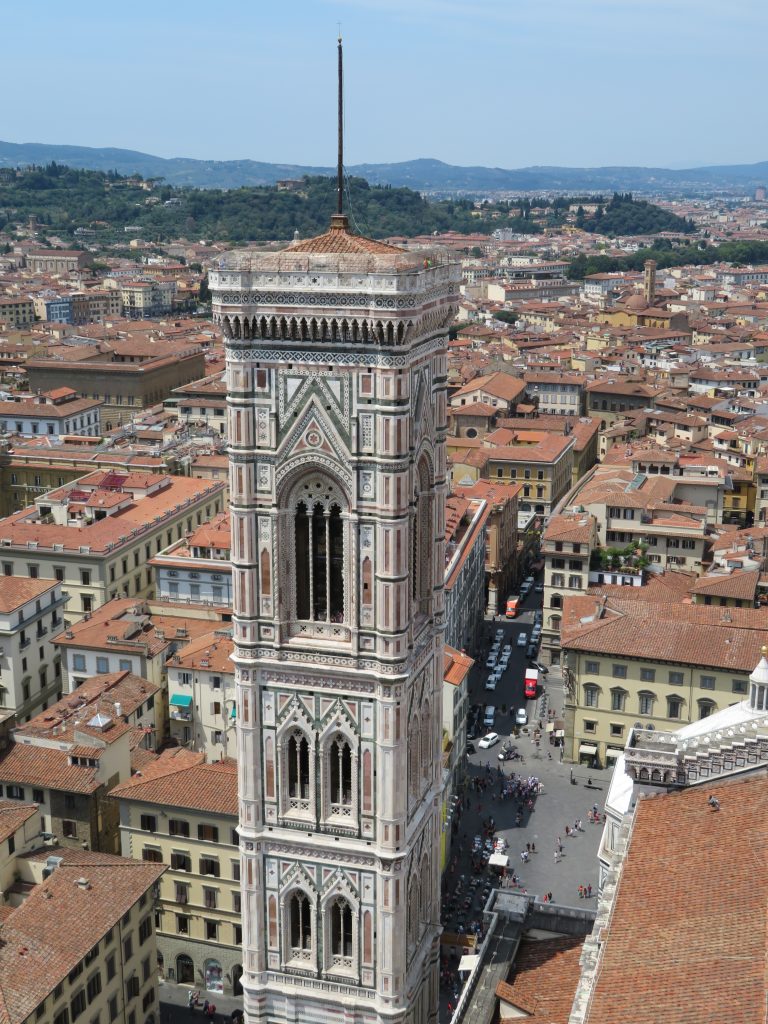
Campanile, exterior.
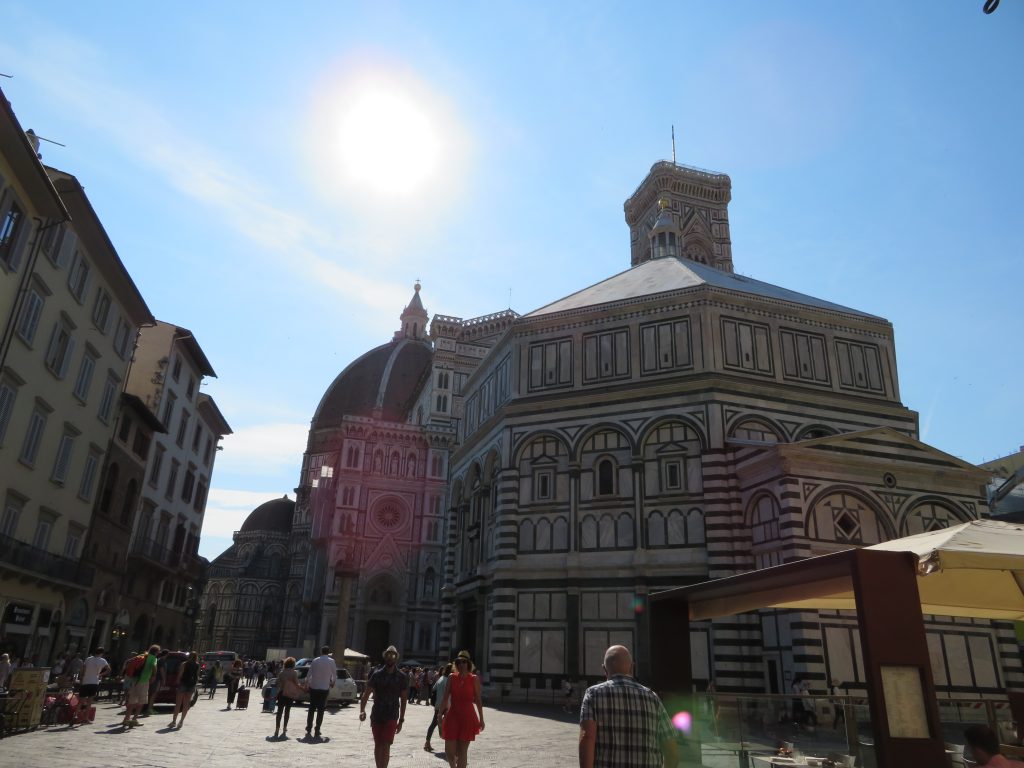
Baptistery of San Giovanni, exterior.
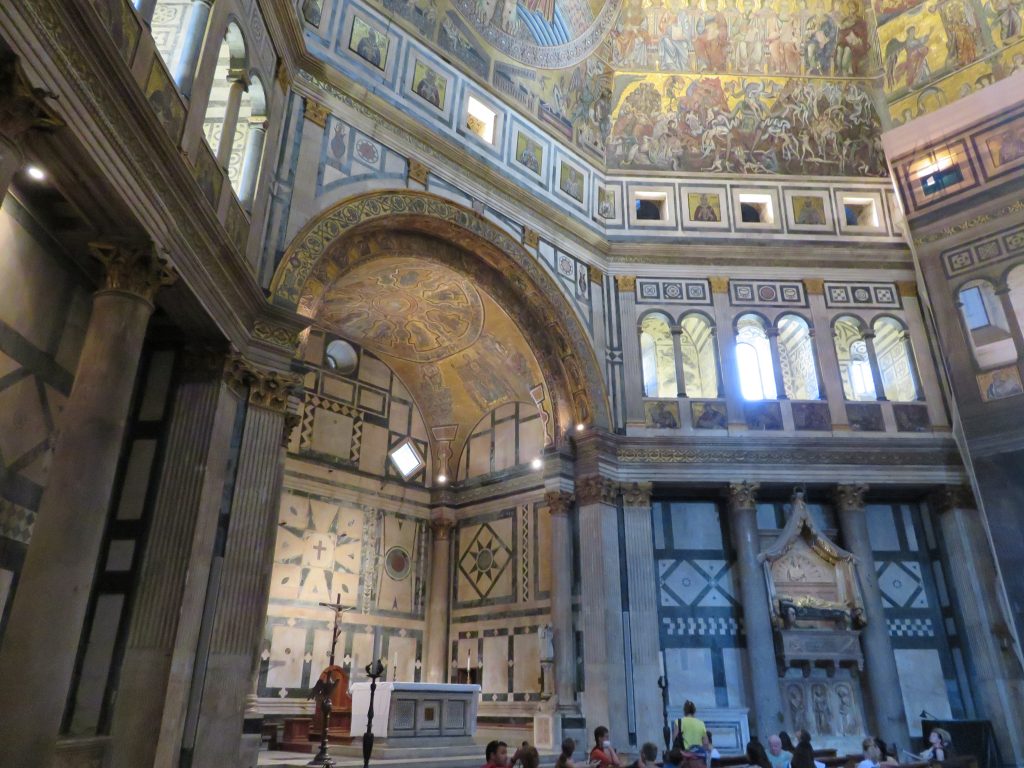
Baptistery of San Giovanni, interior.
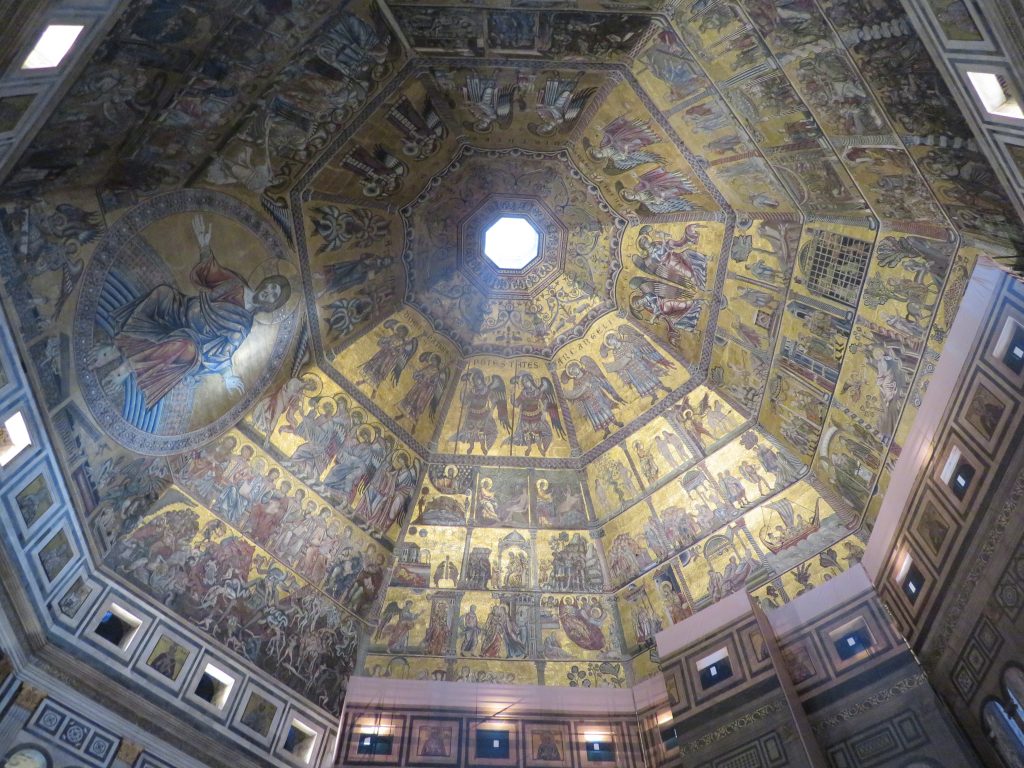
Baptistery of San Giovanni, interior view of dome.
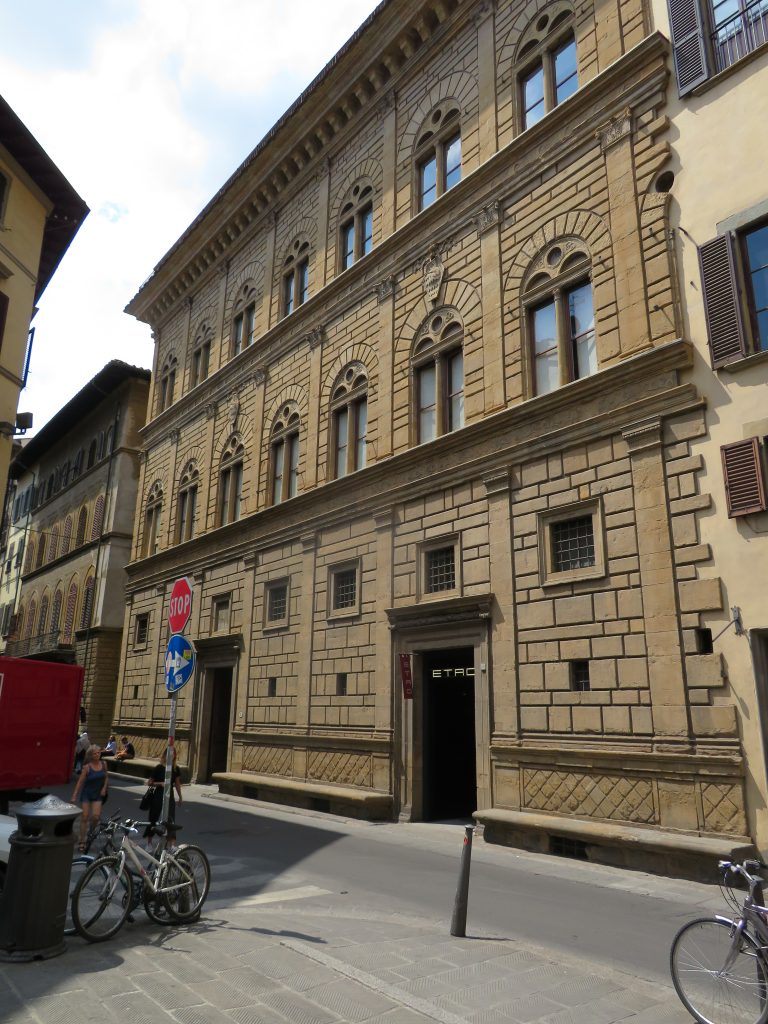
Palazzo Rucellai, exterior.
July 13th: A Casa!
My flight to Paris left at 6:35 am, which meant I had to leave at about 3:30 am and get up around 2:30 am! Fortunately, after a long day of walking in the heat I was able to force myself to sleep at around 6:00 pm the previous night, so it wasn’t so bad. The concierge man behind the counter ordered me a taxi, gave me some breakfast, and also handed me a cappuccino (my last Florentine cappuccino, a delicacy I had come to love and look forward to each morning at breakfast)! Before I knew it, taxi had arrived and it was time to go. One fifteen minute taxi ride, one two hour flight, one eight hour flight, one ten minute shuttle ride, and one four hour car ride later, I was back home! I was up for over 24 hours and was ready to sleep at a good bedtime, better luck next time jet-lag! Now that I am back home I have accumulated a wealth of information, and I am excited to start writing a final form of my paper! I am so excited to present on what I have learned, but it will have to wait until October. In the meantime, I will be writing my final paper and preparing, I cannot wait! Although I have physically left Florence, I am lucky enough to be able to mentally stay there for the rest of the summer with my research! Thanks for reading about my research trip!
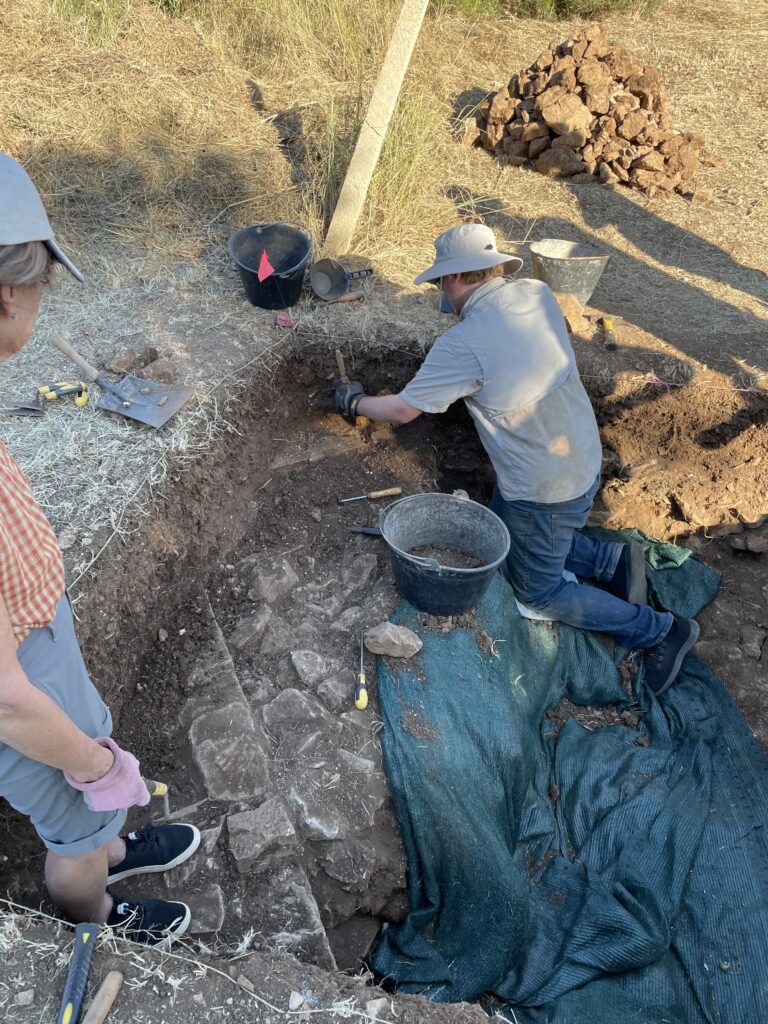
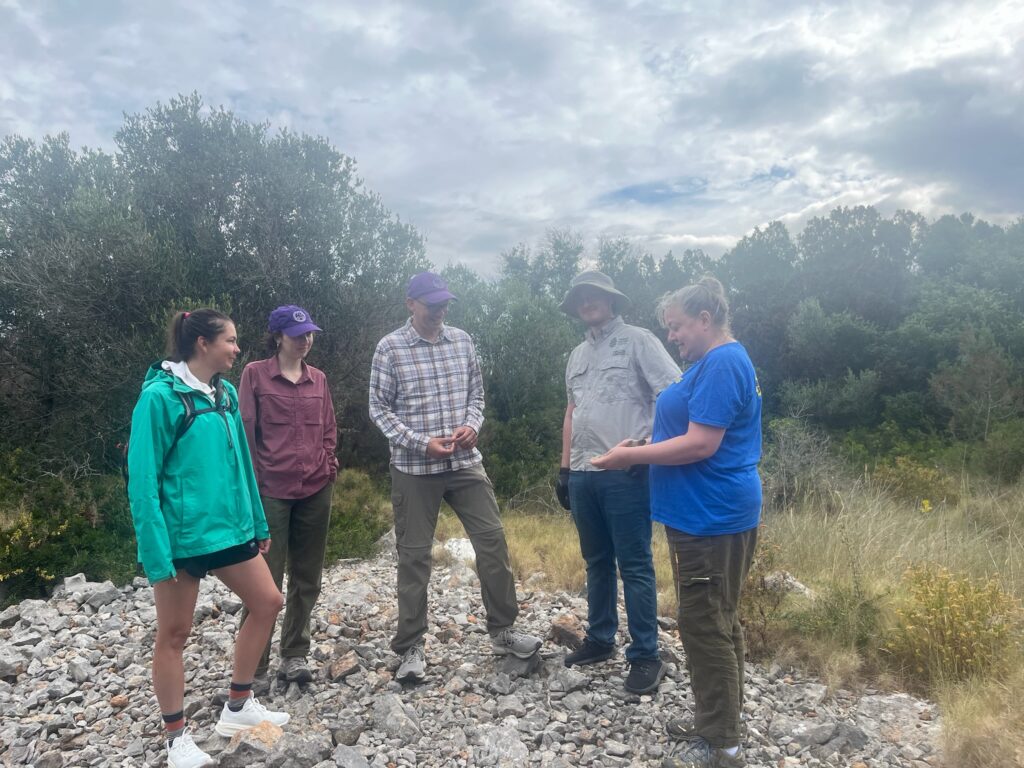 The project’s initial stages involved setting up the excavation site and estimating the location of the old Roman wall. The located wall was in much better condition than expected – walls from the early Roman period are usually better cut than those from later periods and were almost always repurposed for other structures. Excavation continued to the lower layers where the digging ran close to bedrock and the wall’s foundation could be identified, which took most of the remaining time that had been allotted for the dig. The excavation team had other projects running alongside the primary excavation, which members of the crew assisted with as needed.
The project’s initial stages involved setting up the excavation site and estimating the location of the old Roman wall. The located wall was in much better condition than expected – walls from the early Roman period are usually better cut than those from later periods and were almost always repurposed for other structures. Excavation continued to the lower layers where the digging ran close to bedrock and the wall’s foundation could be identified, which took most of the remaining time that had been allotted for the dig. The excavation team had other projects running alongside the primary excavation, which members of the crew assisted with as needed.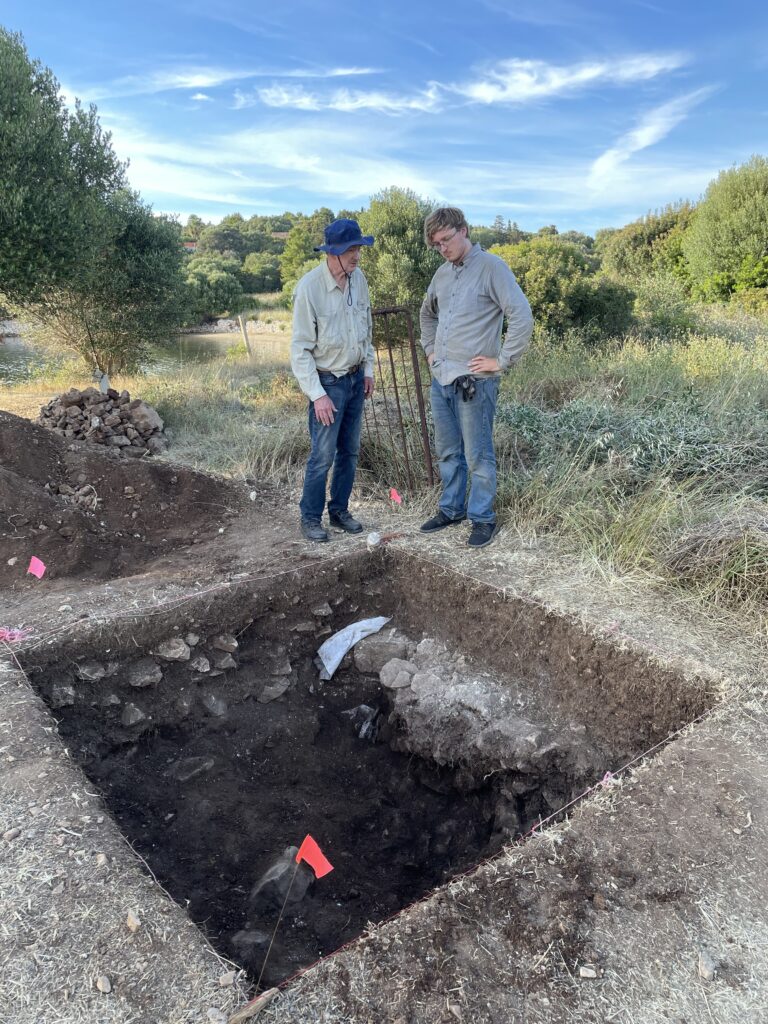

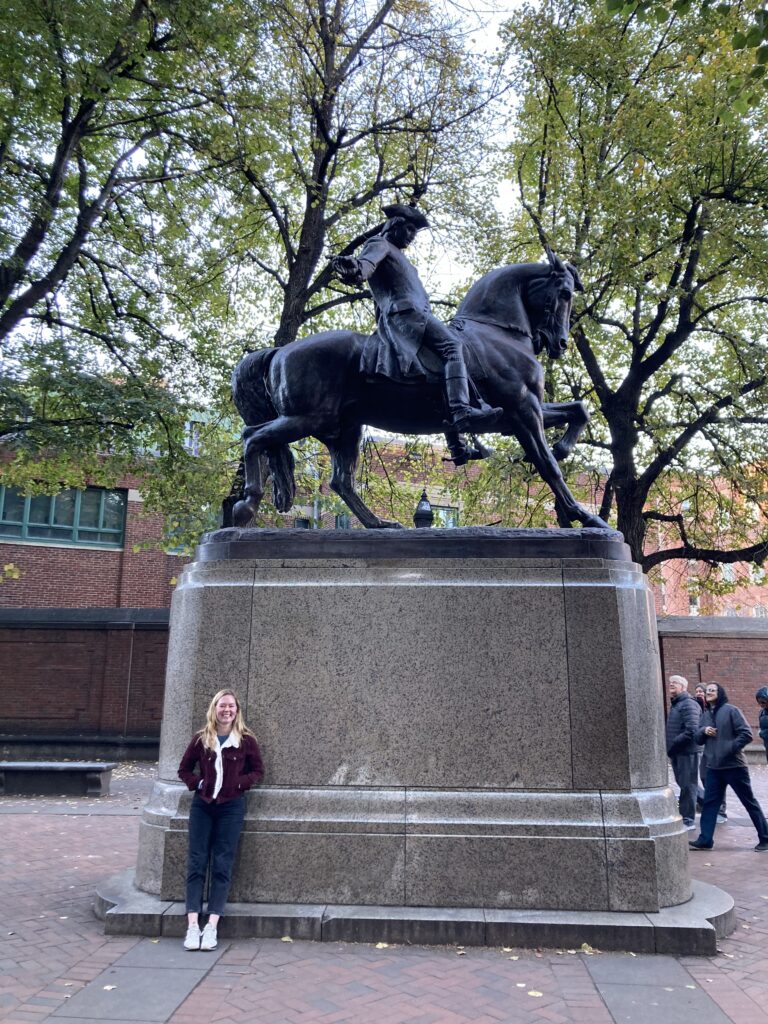
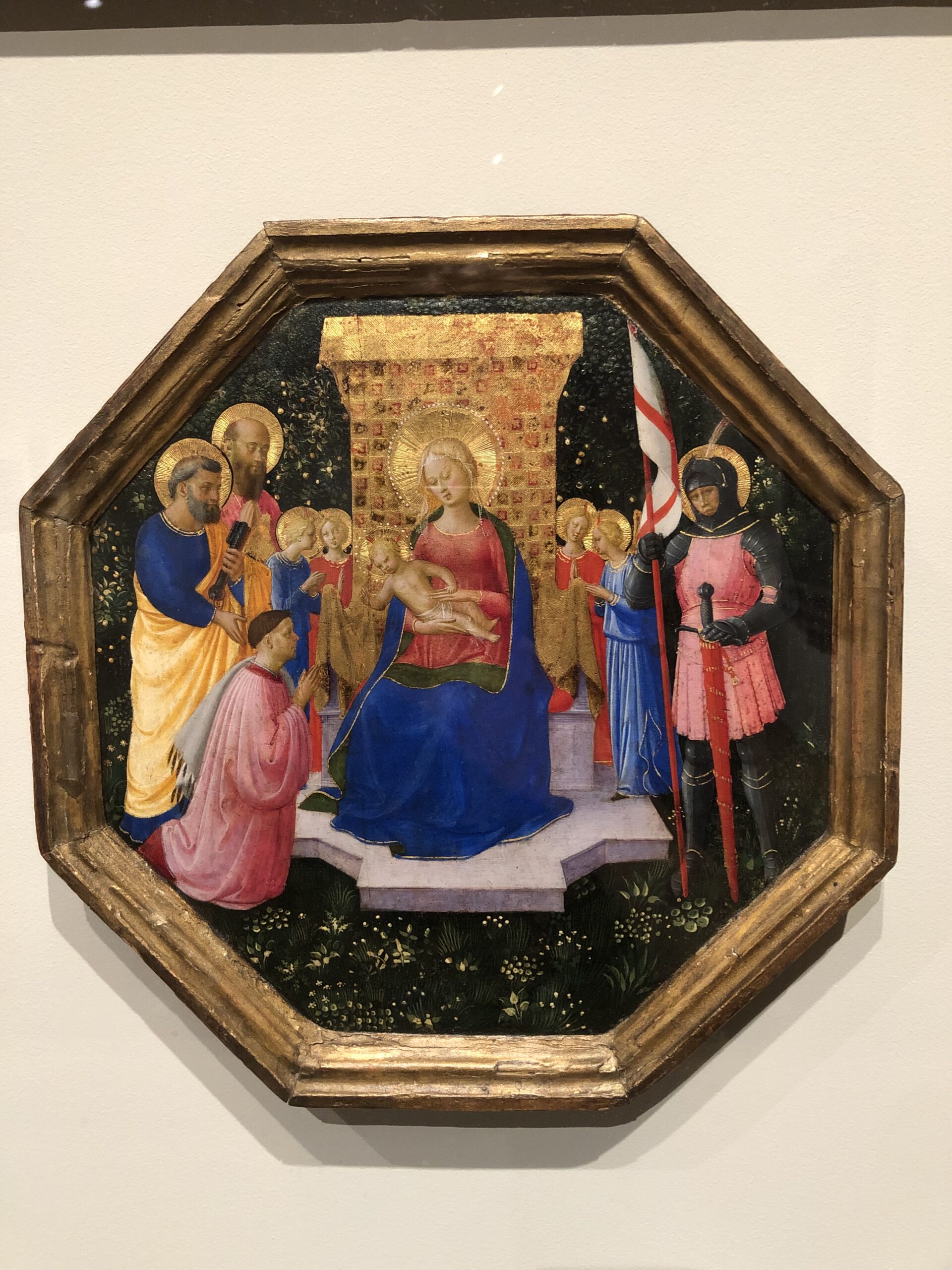
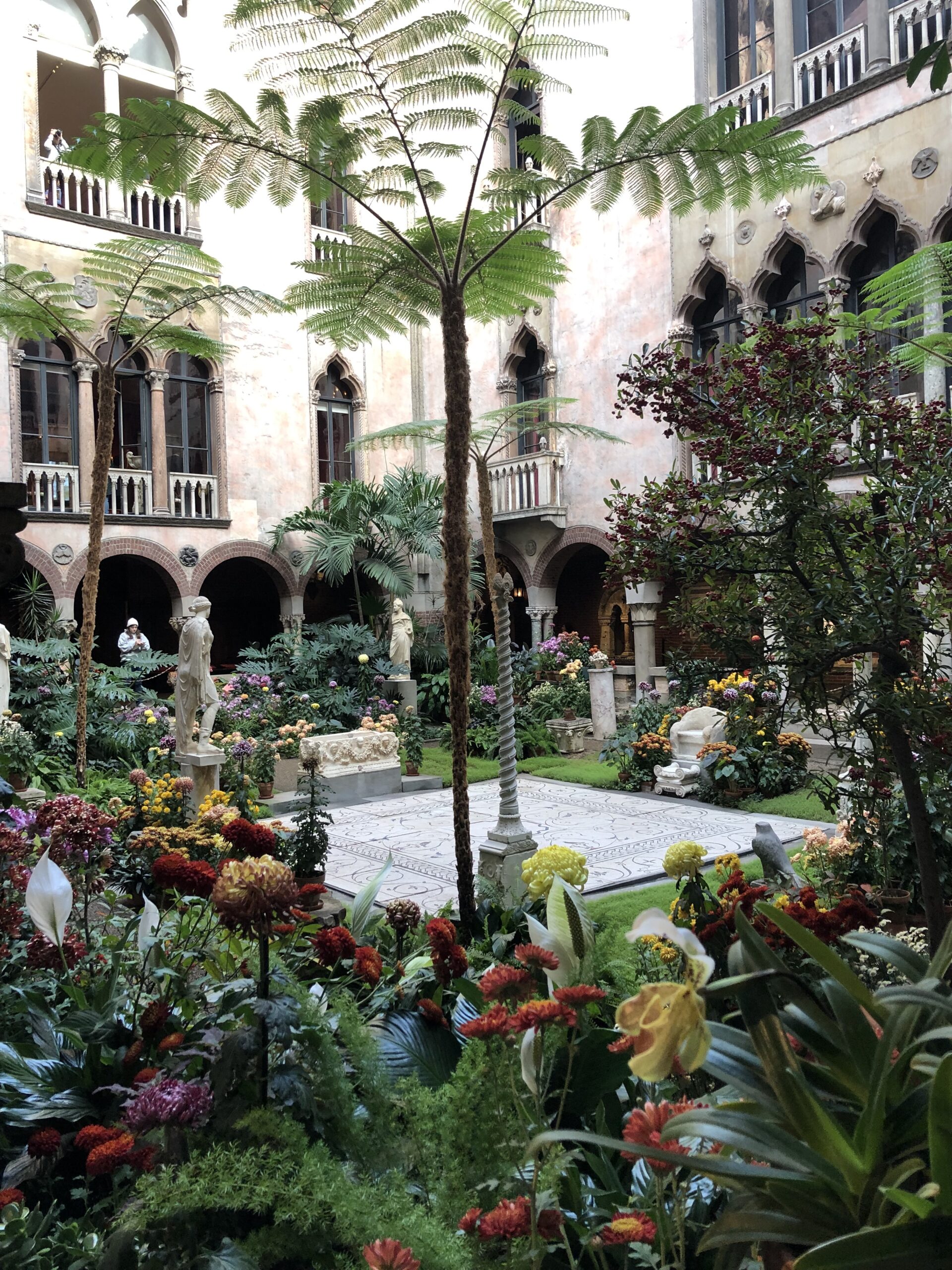






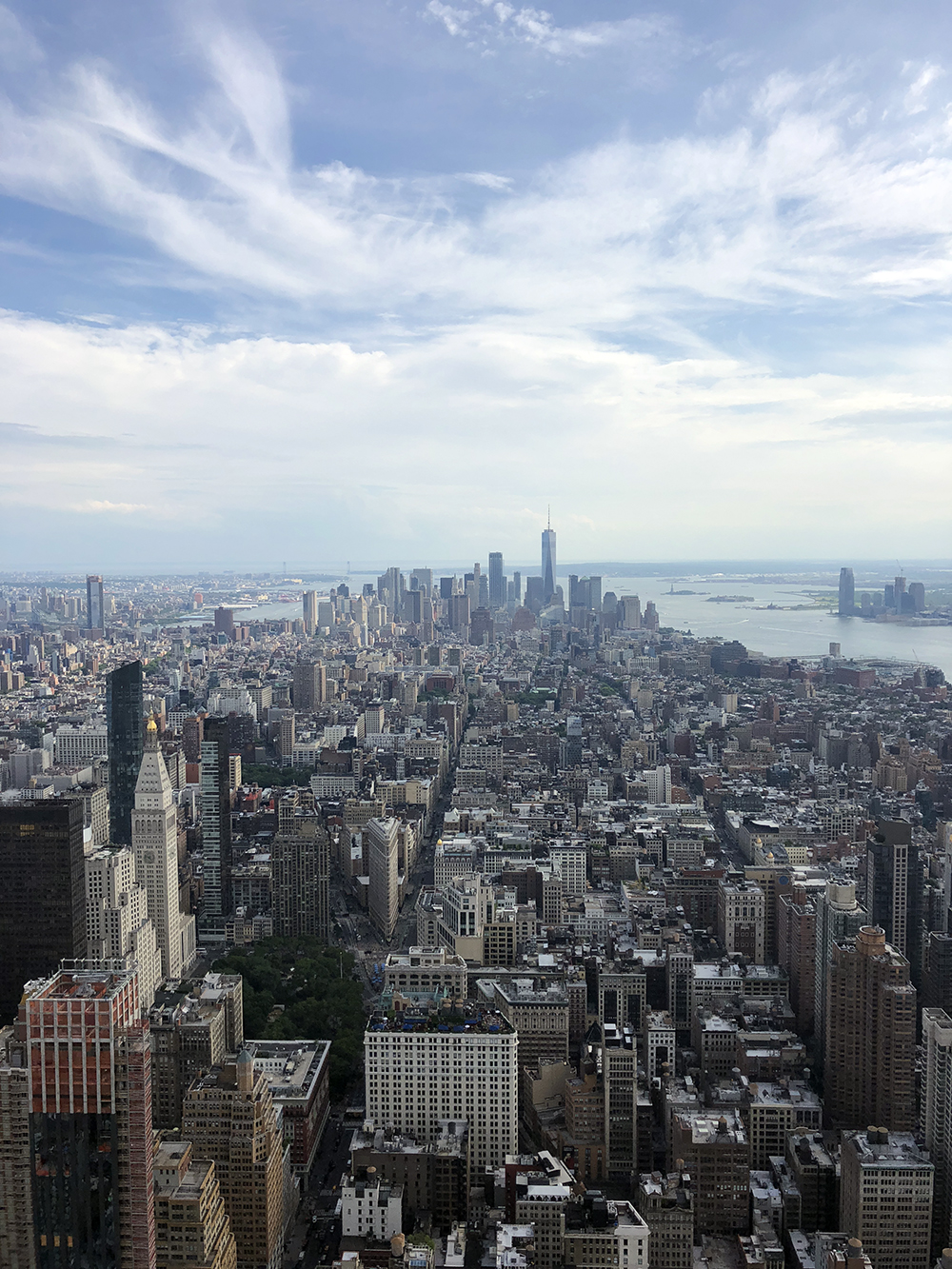
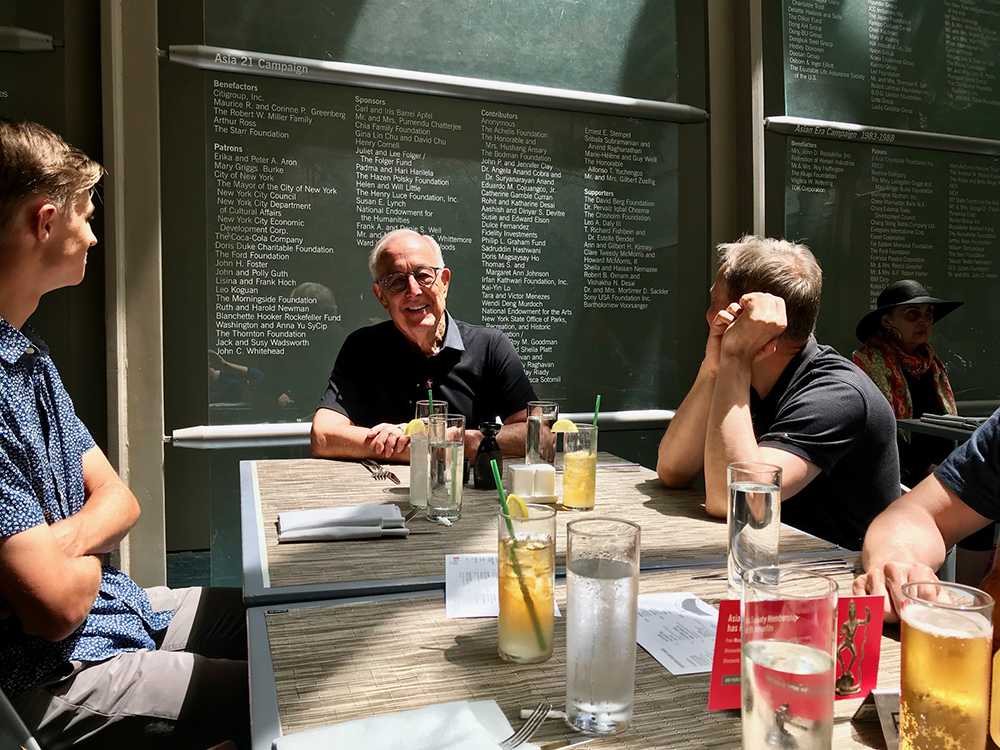
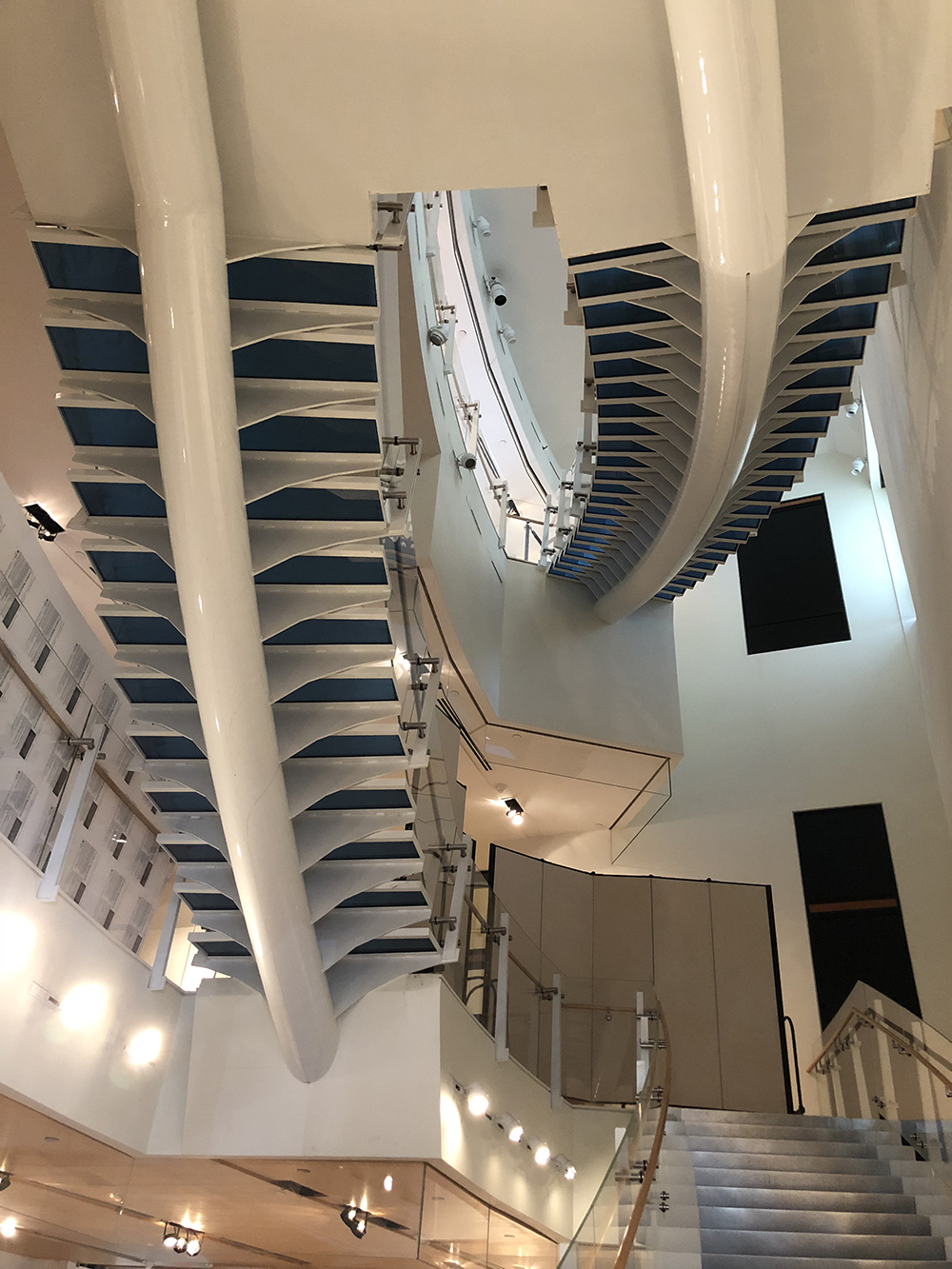
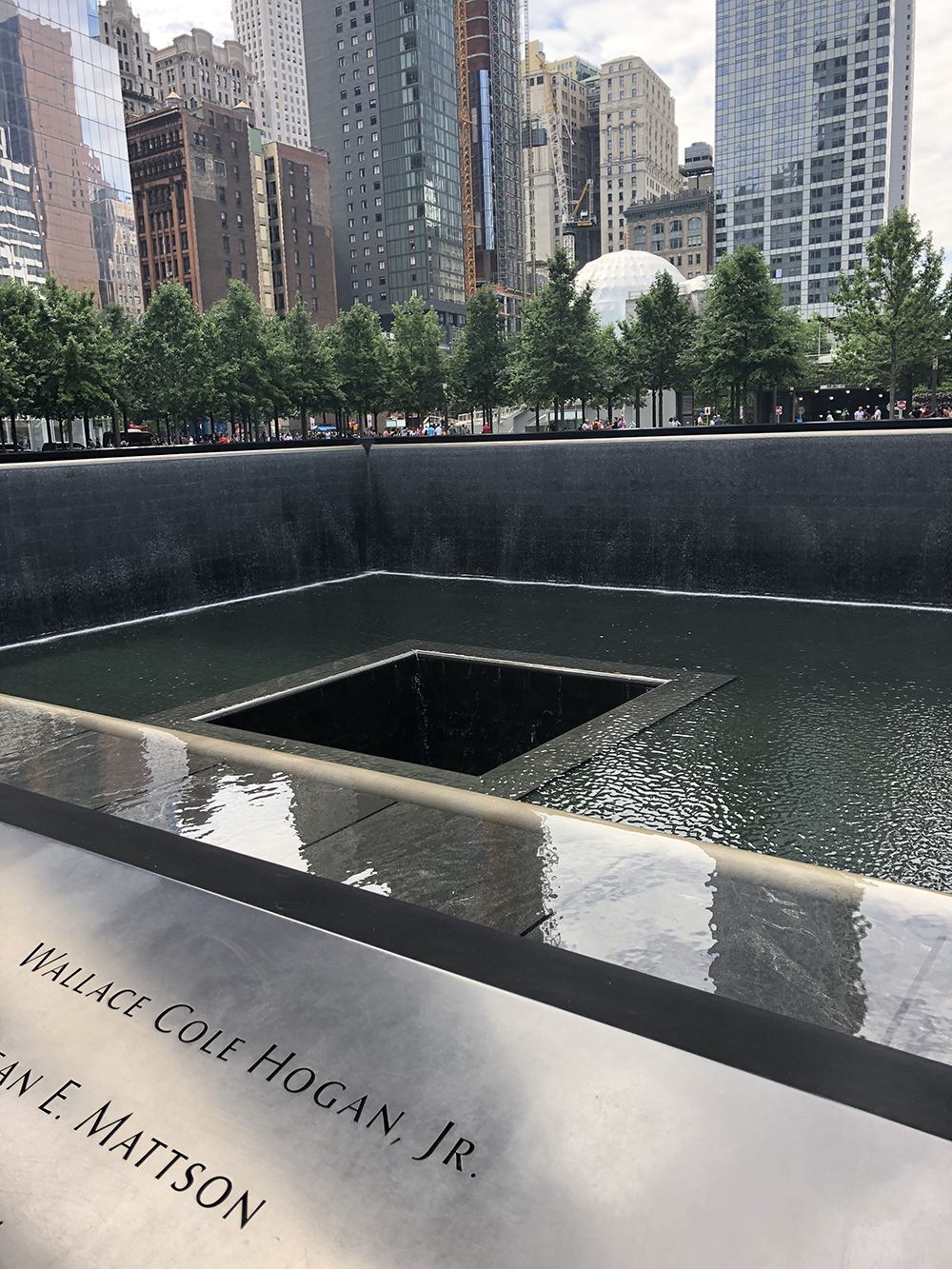
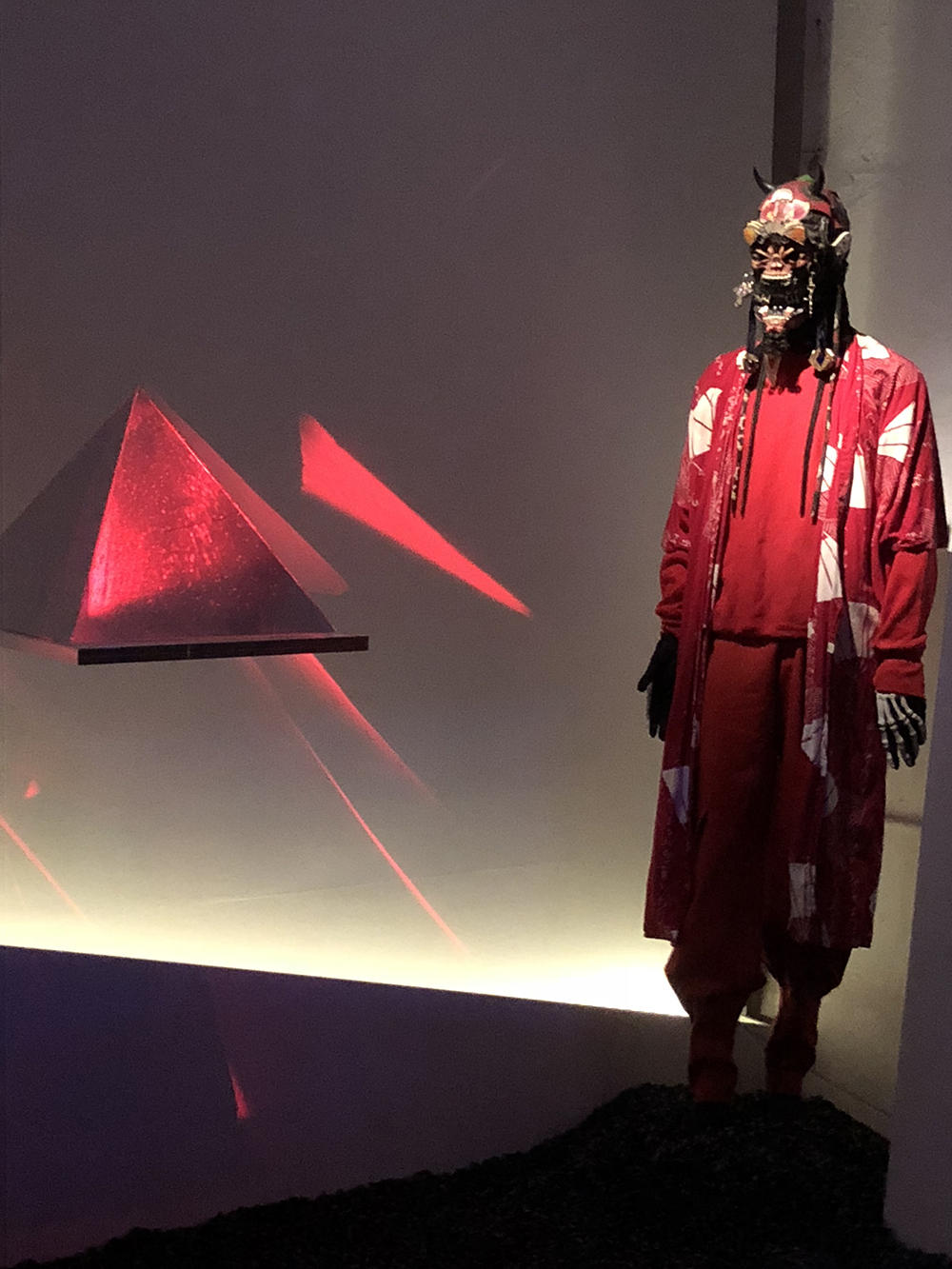
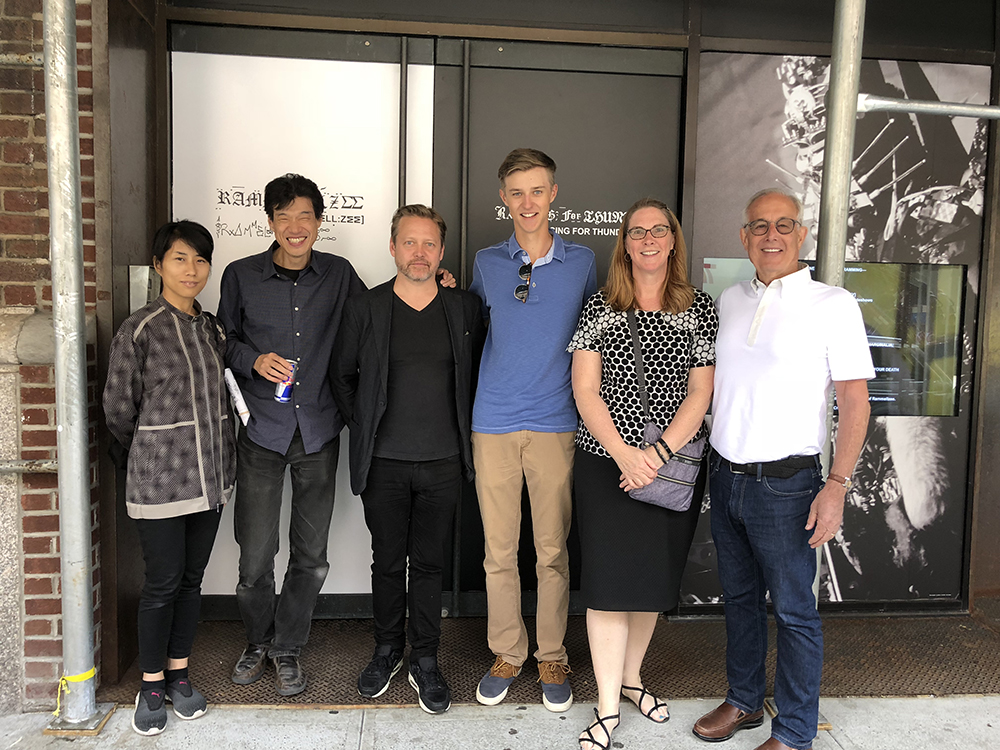






















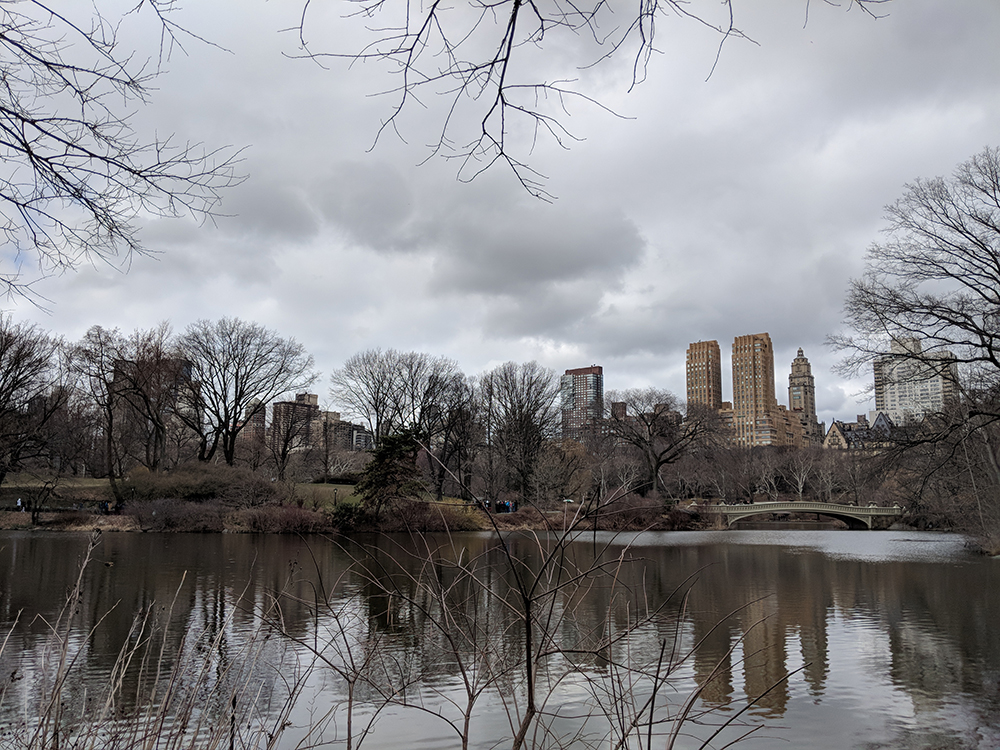
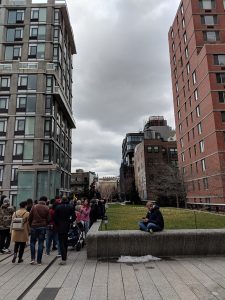
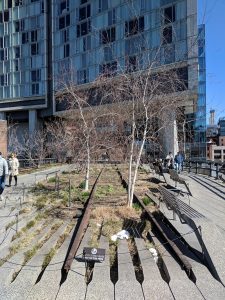
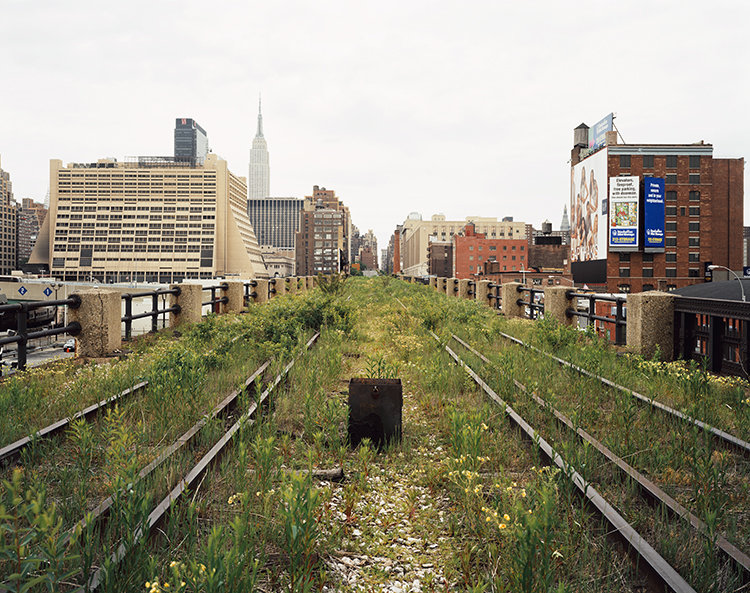
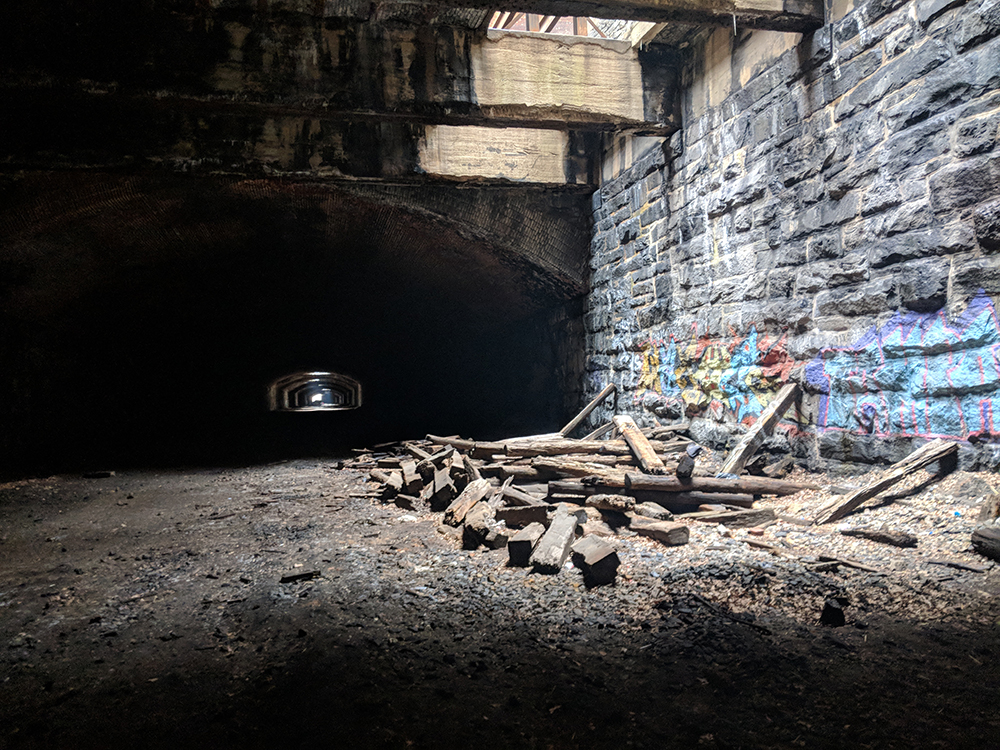
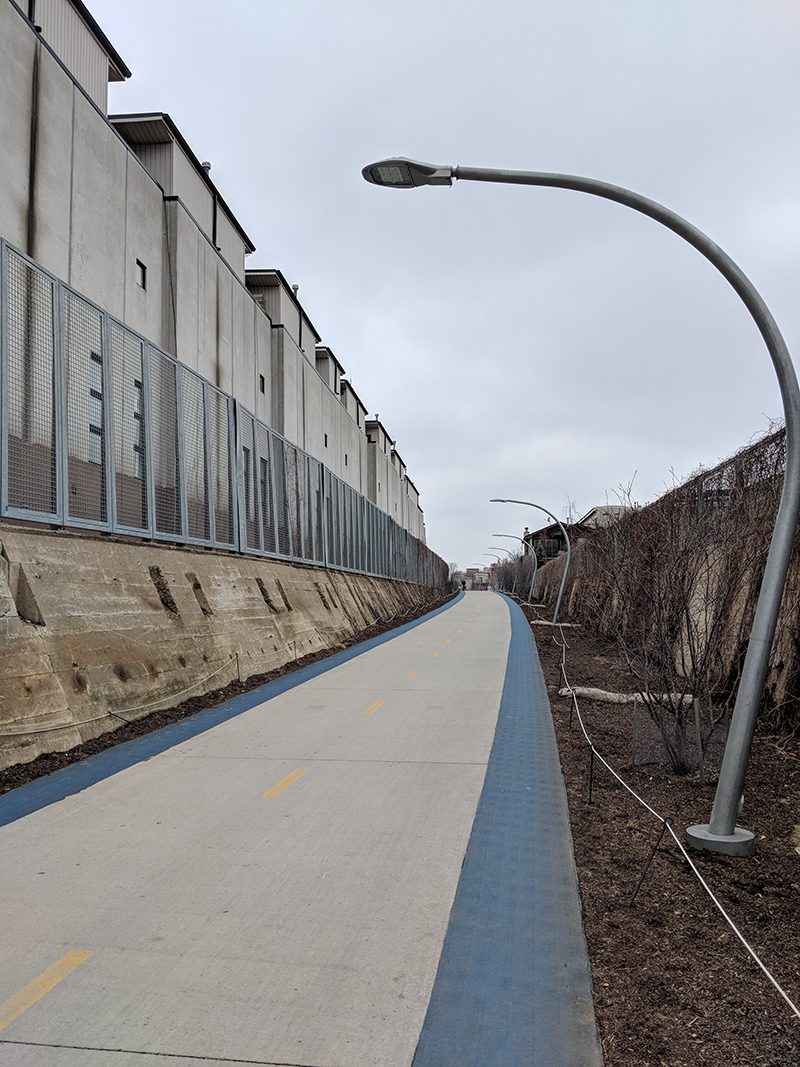

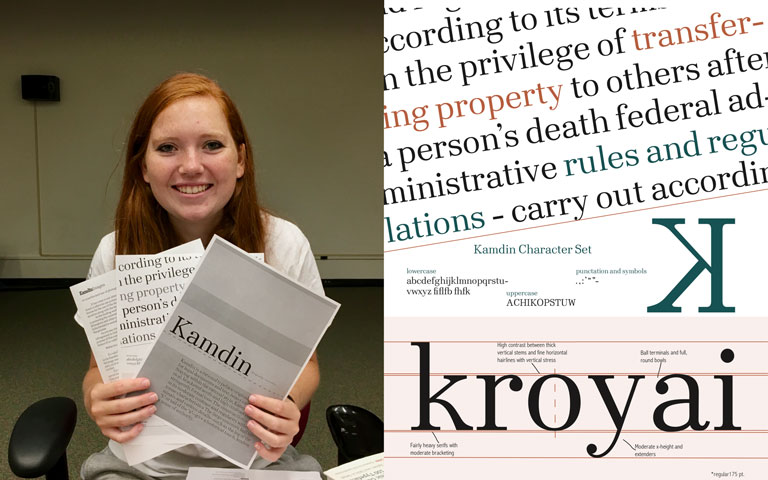
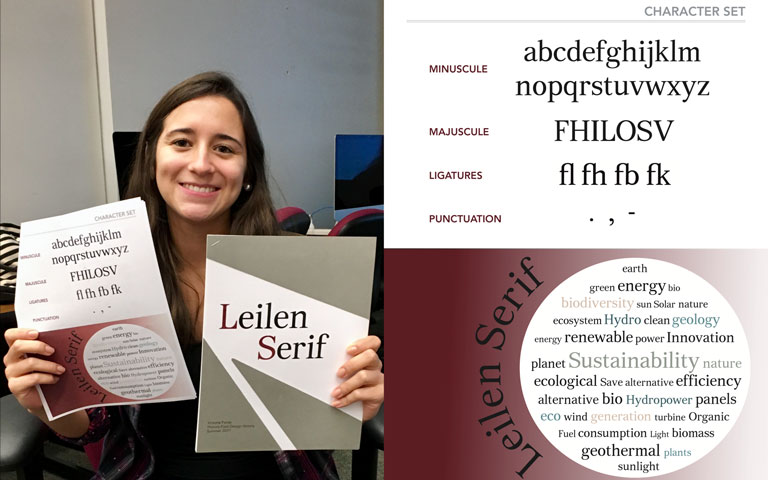 “Named after my sister’s first name, Leilen Serif was created with the purpose of being used in formal documents in the engineering fields such as product reports, instruction manuals, and evaluation forms. However, it could be applied on any text involving small type. The design was fully inspired by the typefaces that constitute the Transitional Serif category of type. These include: Adobe Caslon, Baskerville Original, Mrs Eaves, Plantin, Arnhem, Times New Roman, and Le Monde Journal. The design of Leilen Serif includes serifs with smooth edges, proportionality between individual letters, bracketed transition from the stem to the serif, and moderate contrast between thick and thin parts in order to achieve better legibility.” — Victoria Farias (Electrical Engineering major)
“Named after my sister’s first name, Leilen Serif was created with the purpose of being used in formal documents in the engineering fields such as product reports, instruction manuals, and evaluation forms. However, it could be applied on any text involving small type. The design was fully inspired by the typefaces that constitute the Transitional Serif category of type. These include: Adobe Caslon, Baskerville Original, Mrs Eaves, Plantin, Arnhem, Times New Roman, and Le Monde Journal. The design of Leilen Serif includes serifs with smooth edges, proportionality between individual letters, bracketed transition from the stem to the serif, and moderate contrast between thick and thin parts in order to achieve better legibility.” — Victoria Farias (Electrical Engineering major)